-
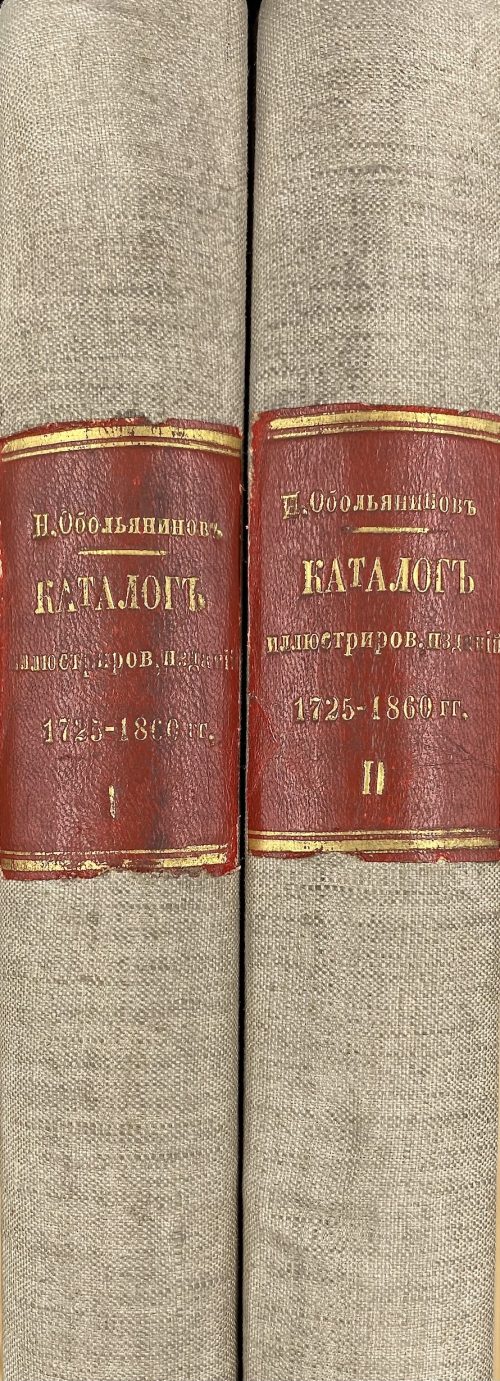 Two volumes, 32 x 24 cm each, uniformly bound in grey cloth with crimson morocco labels with gilt lettering to spine “Н. Обольяниновъ | КАТАЛОГЪ | иллюстриров. изданiй | 1725-1860 гг. | I (II)”, original wrappers preserved. To t.p. verso ink stamps “Latvijas PSR Zinātn̦u akadēmija Fundamentālā bibliotēka”, “1964”, “KATALOGS”, and “Z.A.B. Inv. № 80274”. Printed on laid paper, pagination throughout. 3,038 items with bibliographical descriptions. Title-page: КАТАЛОГЪ | РУССКИХЪ ИЛЛЮСТРИРОВАННЫХЪ | ИЗДАНIЙ | 1725—1860 гг. | — | СОСТАВИЛЪ | Н. Обольяниновъ. | Въ двухъ томахъ | Т. I (II). | ~ | МОСКВА – 1914 (1915). | Товарищество ТИПОГРАФIИ А. И. МАМОНТОВА, | Арбатская пл., Филипповский пер., д. № 11. || Vol. I: Collation: π6 1-424, total 174 leaves; pp.: [i-v] vi-xii, [1] 2-335 [336 errata] (total 348 pages); within green publisher’s wrappers. Vol. II: π2 1-444, total 178 leaves; pp.: [4] [337] 338-686 [687 errata], [688 blank] (total 356 pages); within green publisher’s wrappers. Provenance: Fundamental library of the Latvian Academy of Sciences. Contributors: Николай Александрович Обольянинов (Russian, 1868 – 1916) – author. Анатолий Иванович Ма́монтов (Russian, 1839 – 1905) – publisher.
Two volumes, 32 x 24 cm each, uniformly bound in grey cloth with crimson morocco labels with gilt lettering to spine “Н. Обольяниновъ | КАТАЛОГЪ | иллюстриров. изданiй | 1725-1860 гг. | I (II)”, original wrappers preserved. To t.p. verso ink stamps “Latvijas PSR Zinātn̦u akadēmija Fundamentālā bibliotēka”, “1964”, “KATALOGS”, and “Z.A.B. Inv. № 80274”. Printed on laid paper, pagination throughout. 3,038 items with bibliographical descriptions. Title-page: КАТАЛОГЪ | РУССКИХЪ ИЛЛЮСТРИРОВАННЫХЪ | ИЗДАНIЙ | 1725—1860 гг. | — | СОСТАВИЛЪ | Н. Обольяниновъ. | Въ двухъ томахъ | Т. I (II). | ~ | МОСКВА – 1914 (1915). | Товарищество ТИПОГРАФIИ А. И. МАМОНТОВА, | Арбатская пл., Филипповский пер., д. № 11. || Vol. I: Collation: π6 1-424, total 174 leaves; pp.: [i-v] vi-xii, [1] 2-335 [336 errata] (total 348 pages); within green publisher’s wrappers. Vol. II: π2 1-444, total 178 leaves; pp.: [4] [337] 338-686 [687 errata], [688 blank] (total 356 pages); within green publisher’s wrappers. Provenance: Fundamental library of the Latvian Academy of Sciences. Contributors: Николай Александрович Обольянинов (Russian, 1868 – 1916) – author. Анатолий Иванович Ма́монтов (Russian, 1839 – 1905) – publisher. -
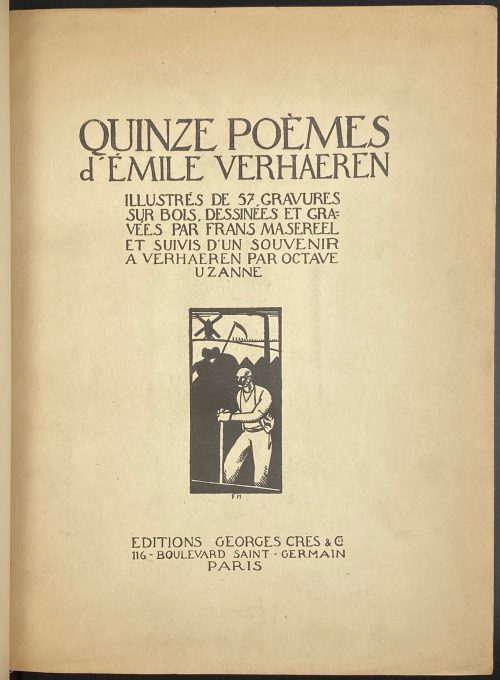 Quinze poèmes d'Emile Verhaeren. Illustrés de 57 gravures sur bois dessinées et gravées par Frans Masereel et suivis d'un 'Souvenir à Verhaeren' par Octave Uzanne. — Paris: Éditions Georges Crès, 1917. Authors: Emile Verhaeren (text), Frans Masereel (illustrations), Octave Uzanne (text). Publisher: Éditions Georges Crès. [Georges-Célestin Crès (1875 - 1935) was a French publisher and bookseller. Address: 116 boulevard Saint-Germain, Paris]. Printer: Sonor S.A. - Geneve, under the direction of Auguste Jordanis. The number of copies printed: 1555 of which 15 (1-15) on Japan paper, 190 (16-205) on Fabriano paper, and 1350 (206-1555) on English paper (1506-1555 not for trade). This copy № 1312. Pagination: [i] - front cover, [ii] - half-title, [iii] - title, [iv] - printrun justification, [v] - table of contents, [vi] - blank, [i-vii] viii-ciii, [civ] - printer statement, [cv] - back cover; one-side (recto) printing and pagination. Owner's contemporary red half-Morocco with marbled boards; spine with four raised bands, gilt lettering and design elements. Original printed paper wrappers preserved. Marbled endpapers. Trimmed unevenly.
Quinze poèmes d'Emile Verhaeren. Illustrés de 57 gravures sur bois dessinées et gravées par Frans Masereel et suivis d'un 'Souvenir à Verhaeren' par Octave Uzanne. — Paris: Éditions Georges Crès, 1917. Authors: Emile Verhaeren (text), Frans Masereel (illustrations), Octave Uzanne (text). Publisher: Éditions Georges Crès. [Georges-Célestin Crès (1875 - 1935) was a French publisher and bookseller. Address: 116 boulevard Saint-Germain, Paris]. Printer: Sonor S.A. - Geneve, under the direction of Auguste Jordanis. The number of copies printed: 1555 of which 15 (1-15) on Japan paper, 190 (16-205) on Fabriano paper, and 1350 (206-1555) on English paper (1506-1555 not for trade). This copy № 1312. Pagination: [i] - front cover, [ii] - half-title, [iii] - title, [iv] - printrun justification, [v] - table of contents, [vi] - blank, [i-vii] viii-ciii, [civ] - printer statement, [cv] - back cover; one-side (recto) printing and pagination. Owner's contemporary red half-Morocco with marbled boards; spine with four raised bands, gilt lettering and design elements. Original printed paper wrappers preserved. Marbled endpapers. Trimmed unevenly. -
 Magazine article by Edgar Jepson: The Iron Tsuba of Japan (Section: Oriental Art), published in volume Vol. 70 (September–December) of The Connoisseur: An Illustrated Magazine for Collectors, Vol. 70 (September–December); pp. 143-152 / C. Reginald Grundy [ed.] — London: Published by the Proprietor, W. CLAUSE JOHNSON, at the Editorial and Advertisement Offices of The Connoisseur, 1924. Owner's half black morocco, gilt lettering to spine, blue cloth boards. Two volumes bound together without original covers. Size 28.5 x 22 cm. Vol. 1: The Connoisseur | An Illustrated Magazine | For Collectors | Edited by C. Reginald Grundy | Vol. LXIX. | (MAY—AUGUST, 1924) | LONDON | Published by the Proprietor, W. CLAUSE JOHNSON, at the | Editorial and Advertisement Offices of The Connoisseur, | at 1, Duke Street, St. James's, S.W. 1 | 1924 || Pp.: [i-ii] iii-xviii [xix] [1, 2 - plate] 3-249 [250]. Vol. 2: The Connoisseur | An Illustrated Magazine | For Collectors | Edited by C. Reginald Grundy | Vol. LXX. | (SEPTEMBER—DECEMBER, 1924) | LONDON | Published by the Proprietor, W. CLAUSE JOHNSON, at the | Editorial and Advertisement Offices of The Connoisseur, | at 1, Duke Street, St. James's, S.W. 1 | 1924 || Pp.: [i-ii] iii-xxii [2 blanks] [1, 2 - plate] 3-261 [262]. The Iron Tsuba of Japan by Edgar Jepson The heart of Japan was in the sword. However admirable may be the paintings, the prints, the netsuke, the lacquer, or the bronzes of the Japanese masters, the supreme artistic achievements of Japan were the blades of Masamune, Muramasa, Sadamune, and Rai Kunitsugu. But not a little of the heart of Japan went also in the tsuba, the guard which protected the hand that wielded the blade, into the iron tsuba of the fighting Samurai. Beside the forgers of the iron tsuba of Japan the ironsmiths of the rest of the world have been mere children. The earliest tsuba were of bronze or copper, often gilded. It is probable that they were replaced by iron tsuba during the Kamakura period, the great fighting era, which lasted from A.D. 1185 to 1333. During the later half of the twelfth century leather tsuba, strengthened by thin iron plates or a metal rim, also replaced the bronze and copper tsuba. It was at this time that a family of armourers of the name of Masuda, and in particular Masuda Munesuke, the founder of the Myochin family, began to forge iron tsuba — thin, round plates of great hardness and density. But it is probable that no tsuba perforated with a view to decorative effects were forged before the end of the fourteenth century. These fourteenth-century tsuba are exceedingly rare in England. I have seen none in the museums, none in the famous collections that have been sold during the last ten years. Those photographed in Herr Oeder's book might easily be the fifteenth century. No. 1 is a curious cup-shape tsuba decorated with a bronze and copper inlay. No. 2, with its edges curiously twisted in the forging, looks like Myochin work. But it is not of the Myochin iron. The Myochin family produced some of the greatest ironsmiths of Japan. Armourers first of all, tsubasmiths, forgers of sake-kettles, articulated reptiles, crustacea, and insects — everything that can be done with iron they did; they pushed their medium to its limit. They were forging iron tsuba in 1160, and they were still forging them in 1860. And it was their own iron, or rather their own steel. They discovered the secret of it early, and they kept that secret in the family for all those hundreds of years. There is no mistaking a Myochin tsuba: balance it on your finger and tap it with a piece of metal, always it gives forth a clear bell-like ring that you get from the work of no other ironsmith, Japanese or European. Always the Myochin tsuba is before everything a protection to the hand of the swordsman; to that everything is, as it should be, subordinated. No. 3 is a Myochin tsuba of the fifteenth century, and probably of the early fifteenth century. No. 4, by Myochin Munetaka, perforated with a grotesque figure, is an example of that twisting and twisting of the iron in the forging till it forms a pattern like the grain of wood. The Myochin smiths invented these wood-grain tsuba, and no other smiths equalled them in their forging. In the sixteenth century, the fighting tsuba was probably at its best. It was a century of great tsubasmiths. Then the first Nobuiye, whose tsuba fetched £100 apiece, circa 1800, in Japan, and the first Kaneiye flourished. No. 5 is a tsuba forged by a great smith, Iyesada of Sotome, in the manner of Nobuiye I, decorated with the karakusa tendrils that Nobuiye delighted in, with lightning and clouds. No. 6 is a guard of Sanada Tembo, the chief smith of the Tembo family, stamped, punning fashion, with the character Tembo. Akin to the Tembo tsuba were those of the Kiami and Hoan smiths. Then also the Heianjo smiths and the Owari smiths, especially those of Nagoya and the Yamakichi family, forged their strongest tsuba. Those of the Yamakichi were tested after the forging by being pounded in iron mortars — at least, so the legend runs. But they were a sternly utilitarian family, and I have never seen a Yamakichi tsuba of any beauty. In the later half of the fifteenth century arose the fashion of decorating tsuba with an inlay, zogan, of bronze. The Heianjo tsuba, forged at Kyoto in the latter half of the fifteenth and the beginning of the sixteenth century, were often thus inlaid. The earliest of them were called "Onin", of which No. 7 is an example. In addition to the bronze inlay around the edge, it is inlaid with a representation, some say, of snow; others say, of the duckweed on a pond. No. 8 is probably a Heianjo tsuba, but I am not quite sure about it. The inlaid acacia branches might be very early Shoami work. But to judge by the iron, it is a fifteenth-century tsuba; and the authorities place the beginning of the Shoami school not later than early in the sixteenth century. No. 10 is an example of the Fushimi-zogan, a flat inlay of a light-coloured bronze. These tsuba took their name from the fact that they were first forged at Fushimi, in Yamashiro, in the sixteenth century. It is of the type known as Mon-zukashi, perforated with crests (mon) à jour. The Yoshiro-zogan tsuba were also first forged at Fushimi by Yoshiro Naomasa. They were distinguished from the Fushimi-zogan by the fact that their inlay was generally a little raised-not always-for the inlay of No. 9, a tsuba forged by a later nineteenth-century Yoshiro, is quite flat. It is an interesting tsuba, for, with its decoration grown florid and excessive, it marks the intermediate stage between the simple and delightful designs of the genuine fighting tsuba and the elaborate pictures in gold and silver on the tsuba of the eighteenth-century smiths of Awa and Kyoto, which have become mere ornaments of the goldsmith. The Gomoku-zogan (No. 11) tsuba were probably first forged earlier than the Fushimi and Yoshiro-zogan tsuba. This inlay, in slight relief, is a representation in a light-coloured bronze and copper of twigs caught in the eddies of streams. The seventeenth century and early eighteenth century were the great periods of perforated tsuba. The designs, and they are often admirable, are for the most part in plain fretwork; but they are also chased. No. 12, a crane under an acacia, is a tsuba of a Higo smith, great forgers of fighting tsuba during this period. These smiths also excelled in nunome zogan, a very thin gold and silver inlay, with which they further decorated their perforated guards. The smiths of the Umetada and Shoami families also forged iron tsuba during this period; but their designs, though sometimes pleasing enough, are rarely fine. The best work of Myoju Umetada is in sentoku, not iron. The Choshu smiths, coming later, surpass the perforated guards of both the Umetada and Shoami smiths in beauty of design. No. 13, a lotus in the round, not only fretwork, but also engraved, is a good example of the admirable balance they so often attained in their designs. It is a sufficiently realistic lotus, but yet of a delightful simplicity. In considerable contrast is No. 14, the dragon by Soheishi Soten — one of the only two authentic tsuba of his forging known — the first forger of hikone-bori tsuba, which were in extraordinary favour in Japan during the eighteenth century, and illustrated every important event in Japanese history. It is on the elaborate side, but fine, strong work, and an excellent guard to the hand, for the lighter and more open part, which gives the design its admirable balance, is on the inside, and not exposed to the full swing of an opponent's blade. A few years ago there was a tendency to decry the Namban tsuba as having sprung too directly from foreign sources. But though the original suggestion may have been Chinese, or, as some say, Portuguese, the Japanese made it entirely their own, as characteristically Japanese as anything can well be, but, it must be admitted, of a decadent period. The school took its rise at the beginning of the seventeenth century, and the early tsuba were forged of a specially hard iron, the Wootz, imported from Southern India. No. 15, the signs of the Zodiac, is an excellent tsuba from the fighting point of view. Both it and No. 16 are of quite charming, if elaborate, design, and both of them, with their delicate scroll-work, so astonishingly undercut, are the very last word in the work of the ironsmith-veritable iron lace. To return to the simpler perforated tsuba, the smiths of Akasaka, a suburb of Tokyo, produced probably the most charming designs. Their style derives considerably from the Higo smiths, and their earlier fighting tsuba are very like the Higo tsuba. But always their work was just a little lighter than that of the Higo smiths, and in the end they moved right away from them and became the forgers of very light guards indeed. No. 17, is a representation of the Hiyokudori, the fabulous double bird, in which were reincarnated the souls of the two lovers, Gompachi and Komurasaki; and No. 18, “the tsuba of a hundred ducks "— there are about forty — are characteristic designs of the school. In the work of the Akasaka smiths the balance, which makes the design of a good tsuba so admirable and delightful, attains its height. This admirable balance seems often to be obtained by a deliberate sacrifice of symmetry. About nine hundred and ninety-nine European ironsmiths out of a thousand would have made the right and left sides of the Hiyoku-dori line by line, and perforation by perforation, exactly alike; he would have cut out exactly as many ducks on the one side of “the tsuba of a hundred ducks” as on the other, and made each duck on the right side correspond exactly in position and attitude with a duck on the left side. By variations the tsubasmith attained a finer balance, almost a higher symmetry. No. 19, often called by collectors the "rose-window" tsuba, but really a stylised chrysanthemum, is a favourite design of the Akasaka smiths, but Hizen work and inlaid in the Hizen manner with gold nunome. No. 20 is a Satsuma tsuba of the middle period. The Satsuma smiths of the nineteenth century produced probably the most ornate of all the iron guards, for the most part calibashes and beans with their leaves and tendrils realistic in the extreme, but of charming design. Few crafts have been carried further than that of the tsubasmith; few crafts working in a difficult medium have handled more subjects with greater feeling for beauty or greater liveliness of fancy. It is interesting to note again and again how school influences school, and smith influences smith. But, as in all the applied arts, the finest tsuba were forged by men who never lost sight of the purpose of a tsuba, that it is before everything a protection to the hand, and never subjected that purpose to a passion for virtuosity. Illustrations: No 1. FOURTEENTH-CENTURY TSUBA, WITH BRONZE AND COPPER INLAY No. 2. FOURTEENTH-CENTURY TSUBA, RESEMBLING MYOCHIN WORK No. 3. MYOCHIN TSUBA, FIFTEENTH CENTURY No. 4. MYOCHIN TSUBA, NINETEENTH CENTURY No. 5. SIXTEENTH-CENTURY TSUBA No. 6. SIXTEENTH-CENTURY TSUBA BY IYESADA OF SOTOME BY SANADA TEMBO No. 7. ONIN TSUBA No. 8. HEIANJO (?) TSUBA No. 9. YOSHIRO TSUBA, NINETEENTH CENTURY No. 10. FUSHIMI-ZOGAN, NINETEENTH CENTURY No. 11.- GOMOKU-ZOGAN, SIXTEENTH CENTURY No. 12. HIGO TSUBA, SEVENTEENTH CENTURY No. 13. CHOSHU TSUBA, SEVENTEENTH CENTURY No. 14. SOTEN TSUBA, SEVENTEENTH CENTURY No. 15. NAMBAN TSUBA, EIGHTEENTH CENTURY No. 16. NAMBAN TSUBA, NINETEENTH CENTURY Nos. 17. AND 18. AKASAKA TSUBA, EIGHTEENTH CENTURY No. 19. HIZEN TSUBA, EIGHTEENTH CENTURY No. 20. SATSUMA TSUBA, EIGHTEENTH CENTURY
Magazine article by Edgar Jepson: The Iron Tsuba of Japan (Section: Oriental Art), published in volume Vol. 70 (September–December) of The Connoisseur: An Illustrated Magazine for Collectors, Vol. 70 (September–December); pp. 143-152 / C. Reginald Grundy [ed.] — London: Published by the Proprietor, W. CLAUSE JOHNSON, at the Editorial and Advertisement Offices of The Connoisseur, 1924. Owner's half black morocco, gilt lettering to spine, blue cloth boards. Two volumes bound together without original covers. Size 28.5 x 22 cm. Vol. 1: The Connoisseur | An Illustrated Magazine | For Collectors | Edited by C. Reginald Grundy | Vol. LXIX. | (MAY—AUGUST, 1924) | LONDON | Published by the Proprietor, W. CLAUSE JOHNSON, at the | Editorial and Advertisement Offices of The Connoisseur, | at 1, Duke Street, St. James's, S.W. 1 | 1924 || Pp.: [i-ii] iii-xviii [xix] [1, 2 - plate] 3-249 [250]. Vol. 2: The Connoisseur | An Illustrated Magazine | For Collectors | Edited by C. Reginald Grundy | Vol. LXX. | (SEPTEMBER—DECEMBER, 1924) | LONDON | Published by the Proprietor, W. CLAUSE JOHNSON, at the | Editorial and Advertisement Offices of The Connoisseur, | at 1, Duke Street, St. James's, S.W. 1 | 1924 || Pp.: [i-ii] iii-xxii [2 blanks] [1, 2 - plate] 3-261 [262]. The Iron Tsuba of Japan by Edgar Jepson The heart of Japan was in the sword. However admirable may be the paintings, the prints, the netsuke, the lacquer, or the bronzes of the Japanese masters, the supreme artistic achievements of Japan were the blades of Masamune, Muramasa, Sadamune, and Rai Kunitsugu. But not a little of the heart of Japan went also in the tsuba, the guard which protected the hand that wielded the blade, into the iron tsuba of the fighting Samurai. Beside the forgers of the iron tsuba of Japan the ironsmiths of the rest of the world have been mere children. The earliest tsuba were of bronze or copper, often gilded. It is probable that they were replaced by iron tsuba during the Kamakura period, the great fighting era, which lasted from A.D. 1185 to 1333. During the later half of the twelfth century leather tsuba, strengthened by thin iron plates or a metal rim, also replaced the bronze and copper tsuba. It was at this time that a family of armourers of the name of Masuda, and in particular Masuda Munesuke, the founder of the Myochin family, began to forge iron tsuba — thin, round plates of great hardness and density. But it is probable that no tsuba perforated with a view to decorative effects were forged before the end of the fourteenth century. These fourteenth-century tsuba are exceedingly rare in England. I have seen none in the museums, none in the famous collections that have been sold during the last ten years. Those photographed in Herr Oeder's book might easily be the fifteenth century. No. 1 is a curious cup-shape tsuba decorated with a bronze and copper inlay. No. 2, with its edges curiously twisted in the forging, looks like Myochin work. But it is not of the Myochin iron. The Myochin family produced some of the greatest ironsmiths of Japan. Armourers first of all, tsubasmiths, forgers of sake-kettles, articulated reptiles, crustacea, and insects — everything that can be done with iron they did; they pushed their medium to its limit. They were forging iron tsuba in 1160, and they were still forging them in 1860. And it was their own iron, or rather their own steel. They discovered the secret of it early, and they kept that secret in the family for all those hundreds of years. There is no mistaking a Myochin tsuba: balance it on your finger and tap it with a piece of metal, always it gives forth a clear bell-like ring that you get from the work of no other ironsmith, Japanese or European. Always the Myochin tsuba is before everything a protection to the hand of the swordsman; to that everything is, as it should be, subordinated. No. 3 is a Myochin tsuba of the fifteenth century, and probably of the early fifteenth century. No. 4, by Myochin Munetaka, perforated with a grotesque figure, is an example of that twisting and twisting of the iron in the forging till it forms a pattern like the grain of wood. The Myochin smiths invented these wood-grain tsuba, and no other smiths equalled them in their forging. In the sixteenth century, the fighting tsuba was probably at its best. It was a century of great tsubasmiths. Then the first Nobuiye, whose tsuba fetched £100 apiece, circa 1800, in Japan, and the first Kaneiye flourished. No. 5 is a tsuba forged by a great smith, Iyesada of Sotome, in the manner of Nobuiye I, decorated with the karakusa tendrils that Nobuiye delighted in, with lightning and clouds. No. 6 is a guard of Sanada Tembo, the chief smith of the Tembo family, stamped, punning fashion, with the character Tembo. Akin to the Tembo tsuba were those of the Kiami and Hoan smiths. Then also the Heianjo smiths and the Owari smiths, especially those of Nagoya and the Yamakichi family, forged their strongest tsuba. Those of the Yamakichi were tested after the forging by being pounded in iron mortars — at least, so the legend runs. But they were a sternly utilitarian family, and I have never seen a Yamakichi tsuba of any beauty. In the later half of the fifteenth century arose the fashion of decorating tsuba with an inlay, zogan, of bronze. The Heianjo tsuba, forged at Kyoto in the latter half of the fifteenth and the beginning of the sixteenth century, were often thus inlaid. The earliest of them were called "Onin", of which No. 7 is an example. In addition to the bronze inlay around the edge, it is inlaid with a representation, some say, of snow; others say, of the duckweed on a pond. No. 8 is probably a Heianjo tsuba, but I am not quite sure about it. The inlaid acacia branches might be very early Shoami work. But to judge by the iron, it is a fifteenth-century tsuba; and the authorities place the beginning of the Shoami school not later than early in the sixteenth century. No. 10 is an example of the Fushimi-zogan, a flat inlay of a light-coloured bronze. These tsuba took their name from the fact that they were first forged at Fushimi, in Yamashiro, in the sixteenth century. It is of the type known as Mon-zukashi, perforated with crests (mon) à jour. The Yoshiro-zogan tsuba were also first forged at Fushimi by Yoshiro Naomasa. They were distinguished from the Fushimi-zogan by the fact that their inlay was generally a little raised-not always-for the inlay of No. 9, a tsuba forged by a later nineteenth-century Yoshiro, is quite flat. It is an interesting tsuba, for, with its decoration grown florid and excessive, it marks the intermediate stage between the simple and delightful designs of the genuine fighting tsuba and the elaborate pictures in gold and silver on the tsuba of the eighteenth-century smiths of Awa and Kyoto, which have become mere ornaments of the goldsmith. The Gomoku-zogan (No. 11) tsuba were probably first forged earlier than the Fushimi and Yoshiro-zogan tsuba. This inlay, in slight relief, is a representation in a light-coloured bronze and copper of twigs caught in the eddies of streams. The seventeenth century and early eighteenth century were the great periods of perforated tsuba. The designs, and they are often admirable, are for the most part in plain fretwork; but they are also chased. No. 12, a crane under an acacia, is a tsuba of a Higo smith, great forgers of fighting tsuba during this period. These smiths also excelled in nunome zogan, a very thin gold and silver inlay, with which they further decorated their perforated guards. The smiths of the Umetada and Shoami families also forged iron tsuba during this period; but their designs, though sometimes pleasing enough, are rarely fine. The best work of Myoju Umetada is in sentoku, not iron. The Choshu smiths, coming later, surpass the perforated guards of both the Umetada and Shoami smiths in beauty of design. No. 13, a lotus in the round, not only fretwork, but also engraved, is a good example of the admirable balance they so often attained in their designs. It is a sufficiently realistic lotus, but yet of a delightful simplicity. In considerable contrast is No. 14, the dragon by Soheishi Soten — one of the only two authentic tsuba of his forging known — the first forger of hikone-bori tsuba, which were in extraordinary favour in Japan during the eighteenth century, and illustrated every important event in Japanese history. It is on the elaborate side, but fine, strong work, and an excellent guard to the hand, for the lighter and more open part, which gives the design its admirable balance, is on the inside, and not exposed to the full swing of an opponent's blade. A few years ago there was a tendency to decry the Namban tsuba as having sprung too directly from foreign sources. But though the original suggestion may have been Chinese, or, as some say, Portuguese, the Japanese made it entirely their own, as characteristically Japanese as anything can well be, but, it must be admitted, of a decadent period. The school took its rise at the beginning of the seventeenth century, and the early tsuba were forged of a specially hard iron, the Wootz, imported from Southern India. No. 15, the signs of the Zodiac, is an excellent tsuba from the fighting point of view. Both it and No. 16 are of quite charming, if elaborate, design, and both of them, with their delicate scroll-work, so astonishingly undercut, are the very last word in the work of the ironsmith-veritable iron lace. To return to the simpler perforated tsuba, the smiths of Akasaka, a suburb of Tokyo, produced probably the most charming designs. Their style derives considerably from the Higo smiths, and their earlier fighting tsuba are very like the Higo tsuba. But always their work was just a little lighter than that of the Higo smiths, and in the end they moved right away from them and became the forgers of very light guards indeed. No. 17, is a representation of the Hiyokudori, the fabulous double bird, in which were reincarnated the souls of the two lovers, Gompachi and Komurasaki; and No. 18, “the tsuba of a hundred ducks "— there are about forty — are characteristic designs of the school. In the work of the Akasaka smiths the balance, which makes the design of a good tsuba so admirable and delightful, attains its height. This admirable balance seems often to be obtained by a deliberate sacrifice of symmetry. About nine hundred and ninety-nine European ironsmiths out of a thousand would have made the right and left sides of the Hiyoku-dori line by line, and perforation by perforation, exactly alike; he would have cut out exactly as many ducks on the one side of “the tsuba of a hundred ducks” as on the other, and made each duck on the right side correspond exactly in position and attitude with a duck on the left side. By variations the tsubasmith attained a finer balance, almost a higher symmetry. No. 19, often called by collectors the "rose-window" tsuba, but really a stylised chrysanthemum, is a favourite design of the Akasaka smiths, but Hizen work and inlaid in the Hizen manner with gold nunome. No. 20 is a Satsuma tsuba of the middle period. The Satsuma smiths of the nineteenth century produced probably the most ornate of all the iron guards, for the most part calibashes and beans with their leaves and tendrils realistic in the extreme, but of charming design. Few crafts have been carried further than that of the tsubasmith; few crafts working in a difficult medium have handled more subjects with greater feeling for beauty or greater liveliness of fancy. It is interesting to note again and again how school influences school, and smith influences smith. But, as in all the applied arts, the finest tsuba were forged by men who never lost sight of the purpose of a tsuba, that it is before everything a protection to the hand, and never subjected that purpose to a passion for virtuosity. Illustrations: No 1. FOURTEENTH-CENTURY TSUBA, WITH BRONZE AND COPPER INLAY No. 2. FOURTEENTH-CENTURY TSUBA, RESEMBLING MYOCHIN WORK No. 3. MYOCHIN TSUBA, FIFTEENTH CENTURY No. 4. MYOCHIN TSUBA, NINETEENTH CENTURY No. 5. SIXTEENTH-CENTURY TSUBA No. 6. SIXTEENTH-CENTURY TSUBA BY IYESADA OF SOTOME BY SANADA TEMBO No. 7. ONIN TSUBA No. 8. HEIANJO (?) TSUBA No. 9. YOSHIRO TSUBA, NINETEENTH CENTURY No. 10. FUSHIMI-ZOGAN, NINETEENTH CENTURY No. 11.- GOMOKU-ZOGAN, SIXTEENTH CENTURY No. 12. HIGO TSUBA, SEVENTEENTH CENTURY No. 13. CHOSHU TSUBA, SEVENTEENTH CENTURY No. 14. SOTEN TSUBA, SEVENTEENTH CENTURY No. 15. NAMBAN TSUBA, EIGHTEENTH CENTURY No. 16. NAMBAN TSUBA, NINETEENTH CENTURY Nos. 17. AND 18. AKASAKA TSUBA, EIGHTEENTH CENTURY No. 19. HIZEN TSUBA, EIGHTEENTH CENTURY No. 20. SATSUMA TSUBA, EIGHTEENTH CENTURY -
![George Cruikshank : A Catalogue Raisonné Of The Work Executed During The Years 1806-1877; With Collations, Notes, Approximate Values, Facsimiles, And Illustrationsby Albert M. Cohn, author of a bibliographical catalogue of the printed works illustrated by George Cruikshank, etc. London : Office of "The Bookman's Jounral", 1924. [Cohn, Albert M.]](https://varshavskycollection.com/wp-content/uploads/2021/02/LIB-1650-c-500x630.jpg) GEORGE CRUIKSHANK | A CATALOGUE RAISONNÉ | OF THE WORK EXECUTED | DURING THE YEARS 1806-1877 | WITH COLLATIONS, NOTES, APPROXIMATE VALUES, | FACSIMILES, AND ILLUSTRATIONS | BY | ALBERT M. COHN | Author of A Bibliographical Catalogue of the Printed | Works Illustrated By George Cruikshank, etc. | LONDON |FROM THE OFFICE OF "THE BOOKMAN'S JOURNAL" | 7 HENRIETTA STREET, STRAND, W.C.2 | 1924. Pagination: ffl, [i, ii] – h.t. / Limited edition (122 of 500), [2] – blank / frontis. lith. portrait of G. Cruikshank w/guard, [iii, iv] – t.p. / printed in G.B., [v, vi] – dedicat. / blank, vii-xvi; [1, 2] – f.t. / blank, 3-375, [376] – Imprint., bfl; 31 leaves of plates, some mounted. Binding: size 30 x 24 x 5.5 cm, hardcover, bevelled boards, original brown cloth with gilded lettering to spine. Top edge gilt, other untrimmed; printed on laid paper. To front pastedown: "Ex libris – Fred Robison Heryer" (round, 55 mm, resembles a coin, printed on heavy gold-coloured foil with embossed lettering and an image of a seated man lettered ALEXANDROY in Greek. To back pastedown: Seller's sticker "From the book of J.W.Robinson Co., Seventh & Grand, Los Angeles." J. W. Robinson Co. – a chain of department stores, established by Joseph Winchester Robinson (American, 1846 – 1891). Some Fred Robison Heryer (American, 1907 – 1992) died in Kansas.
GEORGE CRUIKSHANK | A CATALOGUE RAISONNÉ | OF THE WORK EXECUTED | DURING THE YEARS 1806-1877 | WITH COLLATIONS, NOTES, APPROXIMATE VALUES, | FACSIMILES, AND ILLUSTRATIONS | BY | ALBERT M. COHN | Author of A Bibliographical Catalogue of the Printed | Works Illustrated By George Cruikshank, etc. | LONDON |FROM THE OFFICE OF "THE BOOKMAN'S JOURNAL" | 7 HENRIETTA STREET, STRAND, W.C.2 | 1924. Pagination: ffl, [i, ii] – h.t. / Limited edition (122 of 500), [2] – blank / frontis. lith. portrait of G. Cruikshank w/guard, [iii, iv] – t.p. / printed in G.B., [v, vi] – dedicat. / blank, vii-xvi; [1, 2] – f.t. / blank, 3-375, [376] – Imprint., bfl; 31 leaves of plates, some mounted. Binding: size 30 x 24 x 5.5 cm, hardcover, bevelled boards, original brown cloth with gilded lettering to spine. Top edge gilt, other untrimmed; printed on laid paper. To front pastedown: "Ex libris – Fred Robison Heryer" (round, 55 mm, resembles a coin, printed on heavy gold-coloured foil with embossed lettering and an image of a seated man lettered ALEXANDROY in Greek. To back pastedown: Seller's sticker "From the book of J.W.Robinson Co., Seventh & Grand, Los Angeles." J. W. Robinson Co. – a chain of department stores, established by Joseph Winchester Robinson (American, 1846 – 1891). Some Fred Robison Heryer (American, 1907 – 1992) died in Kansas. -
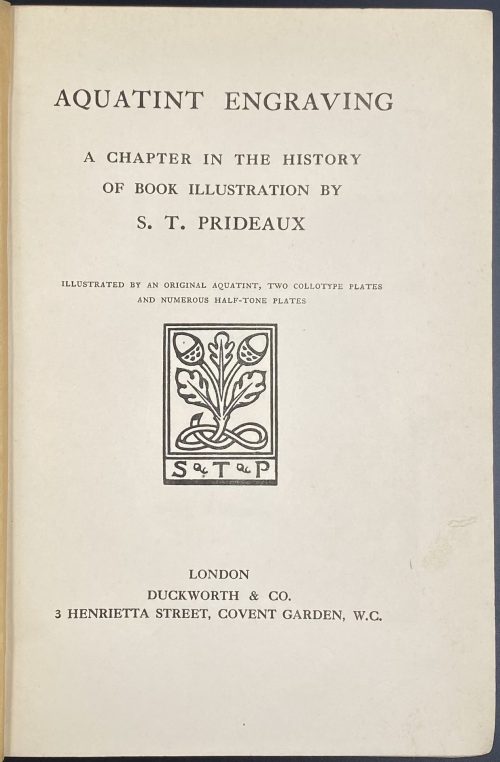 Half-title: AQUATINT ENGRAVING || Title: AQUATINT ENGRAVING | A CHAPTER IN THE HISTORY | OF BOOK ILLUSTRATION BY | S. T. PRIDEAUX | ILLUSTRATED BY AN ORIGINAL AQUATINT, TWO COLLOTYPE PLATES | AND NUMEROUS HALF-TONE PLATES | [Prideaux device] | LONDON | DUCKWORTH & CO. | 3 HENRIETTA STREET, COVENT GARDEN, W.C. || Pagination: ffl, [i, ii] – h.t. / blank, [2] – blank / frontis. w/guard, [iii, iv] – t.p. / coloph. "First Published, December 1909", [v, vi] – dedication "TO MY FATHER" / blank, vii-xv [xvi], [1] 2-434, bfl, + 24 pl. (incl. port). Collation: [a]6 b8 A-Z8 2A-2C8 2D4 Binding: Original navy cloth, gilt-ruled and lettered front board, gilt lettering to spine, a blind device to back board; upper margin gilt, free margin untrimmed. Author: Sarah Prideaux. "Engravers and the books they illustrated": p. 388-405. "Publications by Ackermann with aquatint plates": p. 374-378. "Biographical notices of engravers whose names appear on the plates": p. 358-371. "Books published before 1830 with aquatint plates": p. 325-357.
Half-title: AQUATINT ENGRAVING || Title: AQUATINT ENGRAVING | A CHAPTER IN THE HISTORY | OF BOOK ILLUSTRATION BY | S. T. PRIDEAUX | ILLUSTRATED BY AN ORIGINAL AQUATINT, TWO COLLOTYPE PLATES | AND NUMEROUS HALF-TONE PLATES | [Prideaux device] | LONDON | DUCKWORTH & CO. | 3 HENRIETTA STREET, COVENT GARDEN, W.C. || Pagination: ffl, [i, ii] – h.t. / blank, [2] – blank / frontis. w/guard, [iii, iv] – t.p. / coloph. "First Published, December 1909", [v, vi] – dedication "TO MY FATHER" / blank, vii-xv [xvi], [1] 2-434, bfl, + 24 pl. (incl. port). Collation: [a]6 b8 A-Z8 2A-2C8 2D4 Binding: Original navy cloth, gilt-ruled and lettered front board, gilt lettering to spine, a blind device to back board; upper margin gilt, free margin untrimmed. Author: Sarah Prideaux. "Engravers and the books they illustrated": p. 388-405. "Publications by Ackermann with aquatint plates": p. 374-378. "Biographical notices of engravers whose names appear on the plates": p. 358-371. "Books published before 1830 with aquatint plates": p. 325-357. -
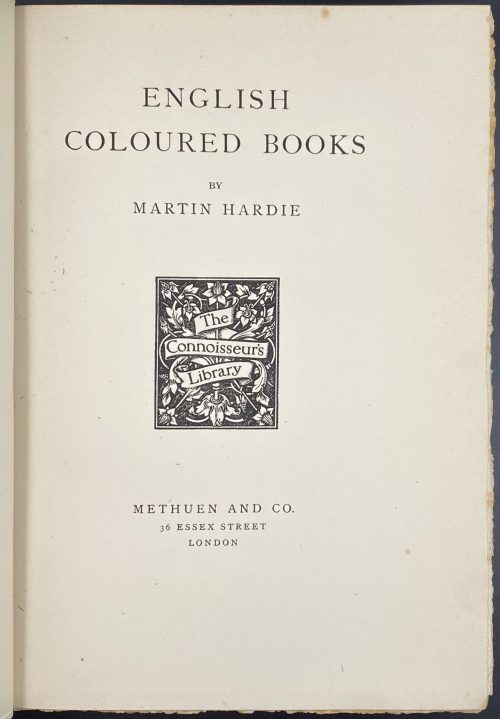 Half-title: THE CONNOISSEURS LIBRARY | GENERAL EDITOR : CYRIL DAVENPORT | […] | ENGLISH COLOURED BOOKS || Title: ENGLISH | COLOURED BOOKS | BY | MARTIN HARDIE | [device: THE CONNOISSEURS LIBRARY] | METHUEN AND CO. | 36 ESSEX STREET | LONDON || Dedication: TO MY WIFE | LOVE’S LABOUR : LOVE’S GIFT Pagination: ffl [i, ii] – h.t. / blank, [2] – blank / frontis. In colour, [iii, iv] – t.p. / First Published in 1906, [v, vi] – dedication / blank, vii-xxiv; 1-339 [340] bfl; 27 sheets of plates, colour and b/w. Collation: 8vo; a8 b4 A-X8 Y2. Binding: Hardcover, 26.3 x 19 x 5.7 cm; red cloth, blind-stamped with repeated fleuron, gilt floral designs and lettering in the frame to front cover, elaborate gilt floral design and lettering to spine; top margin gilt, other untrimmed, some pages uncut; plates w/guards. Printed on laid paper. Printed in Scotland by T. and A. Constable, at the Edinburgh university press. Contributors: Martin Hardie (British, 1875 – 1952) – Author Cyril Davenport (British, 1848 – 1941) – Editor of the series Sir Algernon Methuen (British, 1856 – 1924) – Publisher Thomas Constable (British, 1812 – 1881); Archibald Constable (British, 1774 – 1827) – Founders of the Publishing House "T. and A. Constable".
Half-title: THE CONNOISSEURS LIBRARY | GENERAL EDITOR : CYRIL DAVENPORT | […] | ENGLISH COLOURED BOOKS || Title: ENGLISH | COLOURED BOOKS | BY | MARTIN HARDIE | [device: THE CONNOISSEURS LIBRARY] | METHUEN AND CO. | 36 ESSEX STREET | LONDON || Dedication: TO MY WIFE | LOVE’S LABOUR : LOVE’S GIFT Pagination: ffl [i, ii] – h.t. / blank, [2] – blank / frontis. In colour, [iii, iv] – t.p. / First Published in 1906, [v, vi] – dedication / blank, vii-xxiv; 1-339 [340] bfl; 27 sheets of plates, colour and b/w. Collation: 8vo; a8 b4 A-X8 Y2. Binding: Hardcover, 26.3 x 19 x 5.7 cm; red cloth, blind-stamped with repeated fleuron, gilt floral designs and lettering in the frame to front cover, elaborate gilt floral design and lettering to spine; top margin gilt, other untrimmed, some pages uncut; plates w/guards. Printed on laid paper. Printed in Scotland by T. and A. Constable, at the Edinburgh university press. Contributors: Martin Hardie (British, 1875 – 1952) – Author Cyril Davenport (British, 1848 – 1941) – Editor of the series Sir Algernon Methuen (British, 1856 – 1924) – Publisher Thomas Constable (British, 1812 – 1881); Archibald Constable (British, 1774 – 1827) – Founders of the Publishing House "T. and A. Constable". -
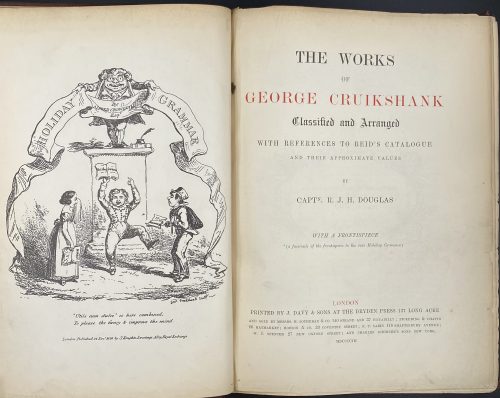 Half-title: THE WORKS | OF | GEORGE CRUIKSHANK | CLASSIFIED AND ARRANGED.|| Title: (in black and red) THE WORKS | OF | GEORGE CRUIKSHANK | CLASSIFIED AND ARRANGED | WITH REFERENCES TO REID'S CATALOGUE | AND THEIR APPROXIMATE VALUES| BY | CAPTN. R. J. H. DOUGLAS | WITH A FRONTISPIECE | (a facsimile of the frontispiece to the rare Holiday Grammar) | LONDON | PRINTED BY J. DAVY & SONS AT THE DRYDEN PRESS 137 LONG ACRE | AND SOLD BY MESSRS. H. SOTHERAN & CO. 140 STRAND AND 37 PICADILLY ; PICKERING & CATTO | 66 HAYMARKET ; ROBSON & CO 23 COVENTRY STREET ; F. T. SABIN 118 SHAFTESBURY AVENUE ; | W. T. SPENSER 27 NEW OXFORD STREET ; AND CHARLES SCRIBNER’S SONS NEW YORK. | MDCCCCIII || Imprint (title verso): One Thousand Copies of this book have been printed and the type distributed. This is No. 205. Bookplate to recto ffl: Reference Library of Francis Edwards Ltd. Not for sale. Inscription to recto ffl: “With the author’s compliments”. Pagination: ffl, [i, ii] – h.t. / blank, [2] – blank / frontis., [iii, iv] – t.p. (black and red) / Print run, [v] v-vi –preface, [2] – contents, [2] – f.t. / note; [1] 2-301 [302] – colophon; insert one sheet with type writing on Francis Edwards letterhead, bfl. (OCLC: ix, 302 pages : illustrations ; 26 cm) Collation: [A]5 B-T8 U7 Binding: Hardcover, burgundy cloth gilt-stamped with title and publisher’s device to front board and gilt lettering to spine.
Half-title: THE WORKS | OF | GEORGE CRUIKSHANK | CLASSIFIED AND ARRANGED.|| Title: (in black and red) THE WORKS | OF | GEORGE CRUIKSHANK | CLASSIFIED AND ARRANGED | WITH REFERENCES TO REID'S CATALOGUE | AND THEIR APPROXIMATE VALUES| BY | CAPTN. R. J. H. DOUGLAS | WITH A FRONTISPIECE | (a facsimile of the frontispiece to the rare Holiday Grammar) | LONDON | PRINTED BY J. DAVY & SONS AT THE DRYDEN PRESS 137 LONG ACRE | AND SOLD BY MESSRS. H. SOTHERAN & CO. 140 STRAND AND 37 PICADILLY ; PICKERING & CATTO | 66 HAYMARKET ; ROBSON & CO 23 COVENTRY STREET ; F. T. SABIN 118 SHAFTESBURY AVENUE ; | W. T. SPENSER 27 NEW OXFORD STREET ; AND CHARLES SCRIBNER’S SONS NEW YORK. | MDCCCCIII || Imprint (title verso): One Thousand Copies of this book have been printed and the type distributed. This is No. 205. Bookplate to recto ffl: Reference Library of Francis Edwards Ltd. Not for sale. Inscription to recto ffl: “With the author’s compliments”. Pagination: ffl, [i, ii] – h.t. / blank, [2] – blank / frontis., [iii, iv] – t.p. (black and red) / Print run, [v] v-vi –preface, [2] – contents, [2] – f.t. / note; [1] 2-301 [302] – colophon; insert one sheet with type writing on Francis Edwards letterhead, bfl. (OCLC: ix, 302 pages : illustrations ; 26 cm) Collation: [A]5 B-T8 U7 Binding: Hardcover, burgundy cloth gilt-stamped with title and publisher’s device to front board and gilt lettering to spine. -
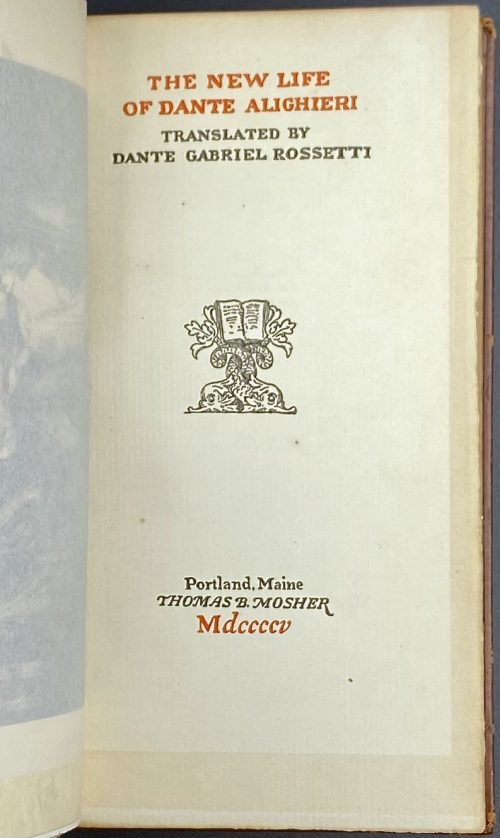 Title: THE NEW LIFE | OF DANTE ALIGHIERI | TRANSLATED BY | DANTE GABRIEL ROSSETTI | {Publisher's device} | Portland, Maine | THOMAS B. MOSHER | Mdccccv Pagination: Ffl [i-viii] ix-xii [xiii] [xiv blank], [1, 2] 3-97 [98] bfl; frontis. w/guard; Note: “This fourth edition on Van Gelder paper consists of 925 copies”. Binding: Hardcover, 18.2 x 10.2 cm, full brown morocco possibly by Sangorski & Sutcliffe, with embossed design elements, raised bands, gilt lettering to spine, TMG, other untrimmed; printed on laid paper with watermark.
Title: THE NEW LIFE | OF DANTE ALIGHIERI | TRANSLATED BY | DANTE GABRIEL ROSSETTI | {Publisher's device} | Portland, Maine | THOMAS B. MOSHER | Mdccccv Pagination: Ffl [i-viii] ix-xii [xiii] [xiv blank], [1, 2] 3-97 [98] bfl; frontis. w/guard; Note: “This fourth edition on Van Gelder paper consists of 925 copies”. Binding: Hardcover, 18.2 x 10.2 cm, full brown morocco possibly by Sangorski & Sutcliffe, with embossed design elements, raised bands, gilt lettering to spine, TMG, other untrimmed; printed on laid paper with watermark. -
![Giacomo Casanova. Erinnerungen aus galanter Zeit / mit Bildern von F. v. Bayros. Eingeleitet von Hanns Heinz Ewers. – Berlin: Wilhelm Borngräber, 1916. – ffl, 2 - cit., advert.] [1-4] 5-557 [558] [2 - table+illustr., printer], bfl.], frontis, and 5 plates.](https://varshavskycollection.com/wp-content/uploads/2021/02/LIB-2512.2020-a-500x712.jpeg) Front board: CASANOVA | Erinnerungen aus | galanter Zeit | Illustriert von | F.v. Bayros | {gigniette} | BERLIN | Verlegt bei Wilhelm Borngräber || Title: Giacomo Casanova | Erinnerungen aus galanter Zeit | Mit Bildern von F.v. Bayros | Eingeleitet von | Hanns Heinz Ewers | 66. Bis 70 Tausend | — | Wilhelm Borngräber Verlag | Berlin || Pagination: [2] , [1-4] 5-557 [558] [2] + frontispice + 5 plates (photogravures). Collation: 8vo; [1]8 2-358. Size: 18.8 x 13 x 4.3 cm Binding: hardcover, quarter cloth, paper boards with vignette and lettering, gilt lettering to spine. Note: the year and the edition were not stated and could not be inferred so far, probably one of the early editions between 1911 and 1925.
Front board: CASANOVA | Erinnerungen aus | galanter Zeit | Illustriert von | F.v. Bayros | {gigniette} | BERLIN | Verlegt bei Wilhelm Borngräber || Title: Giacomo Casanova | Erinnerungen aus galanter Zeit | Mit Bildern von F.v. Bayros | Eingeleitet von | Hanns Heinz Ewers | 66. Bis 70 Tausend | — | Wilhelm Borngräber Verlag | Berlin || Pagination: [2] , [1-4] 5-557 [558] [2] + frontispice + 5 plates (photogravures). Collation: 8vo; [1]8 2-358. Size: 18.8 x 13 x 4.3 cm Binding: hardcover, quarter cloth, paper boards with vignette and lettering, gilt lettering to spine. Note: the year and the edition were not stated and could not be inferred so far, probably one of the early editions between 1911 and 1925. -
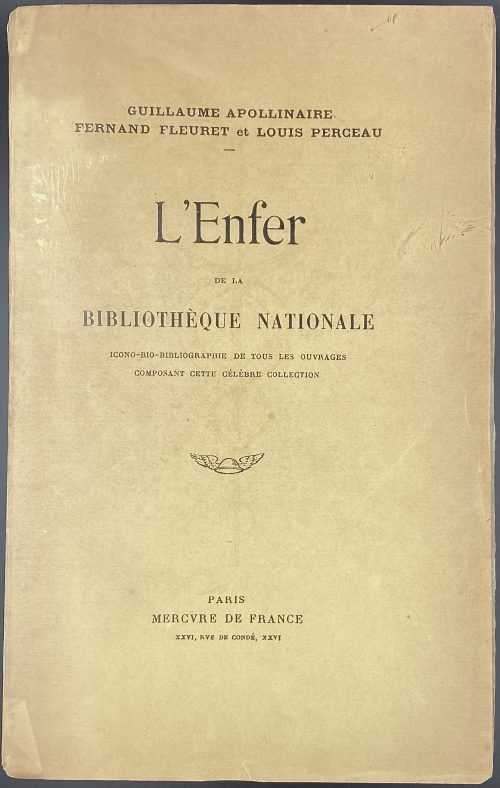 Title: GUILLAUME APOLLINAIRE | FERNAND FLEURET LOUIS PERCEAU | L'Enfer | DE LA | BIBLIOTHÈQUE NATIONALE | ICONO-BIO-BIBLIOGRAPHIE | DESCRIPTIVE, CRITIQUE ET RAISONNÉE, | COMPLÈTE A CE JOUR | DE TOUS LES OUVRAGES COMPOSANT CETTE CÉLÈBRE COLLECTION | AVEC UN INDEX ALPHABÉTIQUE | DES TITRES ET NOMS D'AUTEURS | PARIS | MERCVRE DE FRANCE | XXVI, RVE DE CONDÉ, XXVI | MCMXII || Pagination: ffl, [1-5] 6-415 [416], bfl. Collation: [1]8 2-268. Binding: Original tan wrappers, lettering to covers and spine. Edition: First edition of which this is №952. Ref.: BnF
Title: GUILLAUME APOLLINAIRE | FERNAND FLEURET LOUIS PERCEAU | L'Enfer | DE LA | BIBLIOTHÈQUE NATIONALE | ICONO-BIO-BIBLIOGRAPHIE | DESCRIPTIVE, CRITIQUE ET RAISONNÉE, | COMPLÈTE A CE JOUR | DE TOUS LES OUVRAGES COMPOSANT CETTE CÉLÈBRE COLLECTION | AVEC UN INDEX ALPHABÉTIQUE | DES TITRES ET NOMS D'AUTEURS | PARIS | MERCVRE DE FRANCE | XXVI, RVE DE CONDÉ, XXVI | MCMXII || Pagination: ffl, [1-5] 6-415 [416], bfl. Collation: [1]8 2-268. Binding: Original tan wrappers, lettering to covers and spine. Edition: First edition of which this is №952. Ref.: BnF -
![Адарюковъ В.Я. Добавленiя и исправленiя къ подробномусловарю русскихъ гравированныхъ портретовъ Д.А.Ровинскаго, СПб. 1889. — Издание журнала "Старые годы", 1911. — 89 стр. [Владимир Яковлевич Адарюков (1863 -1932). Добавления и исправления к подробному словарю русских гравированных портретов Д.А.Ровинскаго].](https://varshavskycollection.com/wp-content/uploads/2021/02/LIB-1612-a-500x739.jpg) Title: В. Я. АДАРЮКОВЪ. | ДОБАВЛЕНIЯ И ИСПРАВЛЕНIЯ КЪ ПОДРОБНОМУ СЛОВАРЮ | РУССКИХЪ | ГРАВИРОВАННЫХЪ ПОРТРЕТОВЪ Д. А. РОВИНСКАГО | СПБ. 1889 г. | ИЗДАНИЕ ЖУРНАЛА «СТАРЫЕ ГОДЫ» | 1911. Pagination: [1-4] – incl. orig. wrappers with engraved vignette, 5-89 [90 blank], illustr. Size: 27 x 18.7 cm. Binding: Hardcover; owner's half brown buckram over cloth, original wrappers bound in. Printed on laid paper. Edition: 1st edition, limited: №91 of 150. Inscription to t.p.: Крамарев, 27.5.39. Errata inserts on p. 29 and 77
Title: В. Я. АДАРЮКОВЪ. | ДОБАВЛЕНIЯ И ИСПРАВЛЕНIЯ КЪ ПОДРОБНОМУ СЛОВАРЮ | РУССКИХЪ | ГРАВИРОВАННЫХЪ ПОРТРЕТОВЪ Д. А. РОВИНСКАГО | СПБ. 1889 г. | ИЗДАНИЕ ЖУРНАЛА «СТАРЫЕ ГОДЫ» | 1911. Pagination: [1-4] – incl. orig. wrappers with engraved vignette, 5-89 [90 blank], illustr. Size: 27 x 18.7 cm. Binding: Hardcover; owner's half brown buckram over cloth, original wrappers bound in. Printed on laid paper. Edition: 1st edition, limited: №91 of 150. Inscription to t.p.: Крамарев, 27.5.39. Errata inserts on p. 29 and 77 -
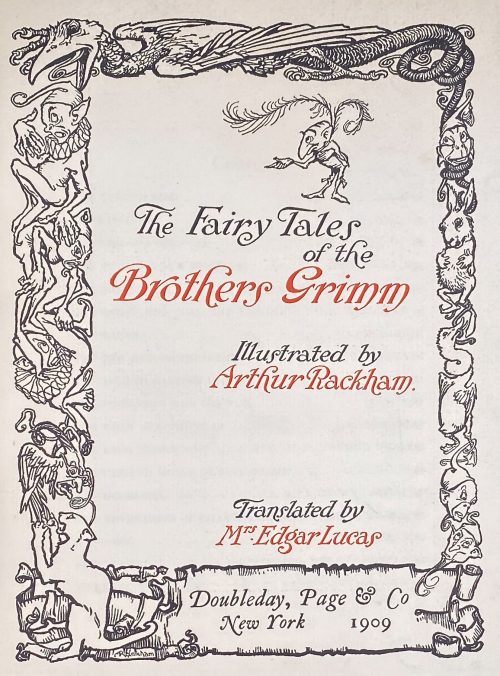 Title (black and red in pictorial frame): The Fairy Tales | of the | Brothers Grimm | Illustrated by Arthur Rackham. | Translated by | Mrs. Edgar Lucas | Doubleday, Page & Co | New York 1909. Pagination: [i-iv] – h.t., t.p., frontis., v-xv [xvi], 1-325 [326] colophon., [1 blank sheet], bfl; 40 tipped-in color plates (offset chromolithograph) with lettered guards, numerous in-text woodcuts. Collation: 4to; a-b4, A-2S4. Edition: 1st deluxe American large-paper edition, limited to 50 copies, Rackham’s facsimile signature to h.t. verso. Binding: Original full limp suede binding with yapp edges, gilt-ornamented and lettered spine. Top edge gilt, other uncut. Moiré endpapers. Printed on laid paper. Marbled endpapers.
Title (black and red in pictorial frame): The Fairy Tales | of the | Brothers Grimm | Illustrated by Arthur Rackham. | Translated by | Mrs. Edgar Lucas | Doubleday, Page & Co | New York 1909. Pagination: [i-iv] – h.t., t.p., frontis., v-xv [xvi], 1-325 [326] colophon., [1 blank sheet], bfl; 40 tipped-in color plates (offset chromolithograph) with lettered guards, numerous in-text woodcuts. Collation: 4to; a-b4, A-2S4. Edition: 1st deluxe American large-paper edition, limited to 50 copies, Rackham’s facsimile signature to h.t. verso. Binding: Original full limp suede binding with yapp edges, gilt-ornamented and lettered spine. Top edge gilt, other uncut. Moiré endpapers. Printed on laid paper. Marbled endpapers. -
 Title: MEMOIRS OF M. THIERS | 1870—1873 | Translated by | F. M. ATKINSON | {publisher’s device} | LONDON: GEORGE ALLEN & UNWIN LTD. | RUSKIN HOUSE 40 MUSEUM STREET, W.C. Pagination: [6] 7-384. Collation: 8vo; [1]-248. Size: 23 x 15 cm Binding: Blue cloth, top and bottom ruled in blind, gilt lettering to front cover and spine. Original: Adolphe Thiers. Notes et souvenirs de M. Thiers, 1870-1873: voyage diplomatique, proposition d'un armistice, préliminaires de la paix, présidence de la République. — Paris : [s.n.], 1901. — 465 p. The preface and editing signed "F. D." [Félicie Dosne]. Félicie Dosne (French, 1823 – 1906) was Thiers's sister-in-law.
Title: MEMOIRS OF M. THIERS | 1870—1873 | Translated by | F. M. ATKINSON | {publisher’s device} | LONDON: GEORGE ALLEN & UNWIN LTD. | RUSKIN HOUSE 40 MUSEUM STREET, W.C. Pagination: [6] 7-384. Collation: 8vo; [1]-248. Size: 23 x 15 cm Binding: Blue cloth, top and bottom ruled in blind, gilt lettering to front cover and spine. Original: Adolphe Thiers. Notes et souvenirs de M. Thiers, 1870-1873: voyage diplomatique, proposition d'un armistice, préliminaires de la paix, présidence de la République. — Paris : [s.n.], 1901. — 465 p. The preface and editing signed "F. D." [Félicie Dosne]. Félicie Dosne (French, 1823 – 1906) was Thiers's sister-in-law. -
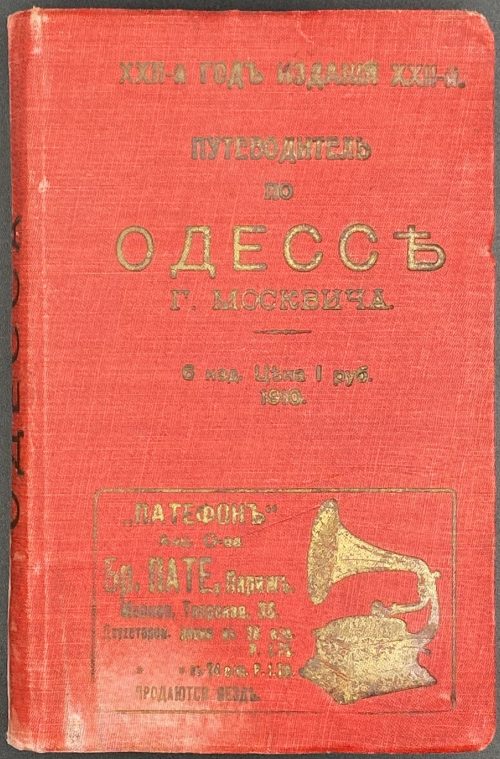 Title: Издательство Путеводителей "Русскiй Бедекеръ" сущ. съ 1888 г. | Григорiй Москвичъ. | ИЛЛЮСТРИРОВАННЫЙ | Практический Путеводитель | по Одессѣ | с приложенiемъ: | очерка одесской выставки, плана Одессы, исполненнаго | в краскахъ, плановъ — порта, Куяльницкаго лимана, | расписанiя рейсовъ пароходовъ и тарифовъ, алфавита | и проч. | ИЗДАНИIЕ ШЕСТОЕ. | Цѣна 1 руб. (в переплетѣ) | ПРОДАЕТСЯ | во всѣх лучшихъ книжныхъ магазинахъ столицъ | и провинцiи. | ОДЕССА. | Типографiя и стереотипия И. Копельмана, Пушк. 34. | 1910. || Binding: Red cloth with gilt lettering to the front board: XXII-й ГОДЪ ИЗДАНIЯ XXII-й | ПУТЕВОДИТЕЛЬ | ПО | ОДЕССѢ | Г. МОСКВИЧА. | 6 изд. Цѣна 1 руб. | 1910. [Pictorial advert.], to the back board: Text. advert. in gilt; to spine: ОДЕССА. Pink end-papers with advertisement. Pagination: [i-ii - t.p. /advert.] [iii]-iv - preface to 6th edition; [v]-viii - content; [ix]-xvi - index; 11 leaves advert., unpag; [i]-xii - Odessa exhibition; [1] 2-240; [1] 2-8 - schedules; photo plates, 2 folding maps; in-16mo (numerical). Size: 16.5 x 10.5 cm.
Title: Издательство Путеводителей "Русскiй Бедекеръ" сущ. съ 1888 г. | Григорiй Москвичъ. | ИЛЛЮСТРИРОВАННЫЙ | Практический Путеводитель | по Одессѣ | с приложенiемъ: | очерка одесской выставки, плана Одессы, исполненнаго | в краскахъ, плановъ — порта, Куяльницкаго лимана, | расписанiя рейсовъ пароходовъ и тарифовъ, алфавита | и проч. | ИЗДАНИIЕ ШЕСТОЕ. | Цѣна 1 руб. (в переплетѣ) | ПРОДАЕТСЯ | во всѣх лучшихъ книжныхъ магазинахъ столицъ | и провинцiи. | ОДЕССА. | Типографiя и стереотипия И. Копельмана, Пушк. 34. | 1910. || Binding: Red cloth with gilt lettering to the front board: XXII-й ГОДЪ ИЗДАНIЯ XXII-й | ПУТЕВОДИТЕЛЬ | ПО | ОДЕССѢ | Г. МОСКВИЧА. | 6 изд. Цѣна 1 руб. | 1910. [Pictorial advert.], to the back board: Text. advert. in gilt; to spine: ОДЕССА. Pink end-papers with advertisement. Pagination: [i-ii - t.p. /advert.] [iii]-iv - preface to 6th edition; [v]-viii - content; [ix]-xvi - index; 11 leaves advert., unpag; [i]-xii - Odessa exhibition; [1] 2-240; [1] 2-8 - schedules; photo plates, 2 folding maps; in-16mo (numerical). Size: 16.5 x 10.5 cm. -
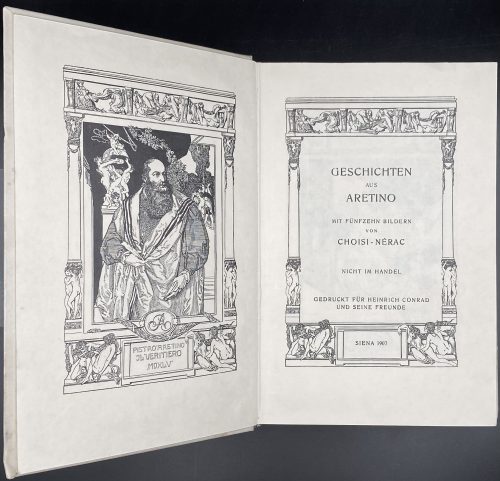 Title: GESCHICHTEN | AUS | ARETINO | MIT FÜNFZEHN BILDERN | VON | CHOISI-NÉRAC | NICHT IM HANDEL | GEDRUCKT FÜR HEINRICH CONRAD | UND SEINE FREUNDE | SIENA 1907 || Collation: 8vo; 1-128 137; frontispiece, t.p. and 14 plates, extraneous to collation. Pagination: [2] f.t. / blank, 3-203 [2], il. Binding: Full cream vellum, ruled with gilt double-fillet, grey label with gilt lettering to spine. Bookplate by von Bayros Par Avi Cigno to front pastedown. Note: Private edition of Aretino's Ragionamenti in German as Geschichten aus Aretino by translater and publisher Heinrich Conrad (German, 1866 – 1918), whose real name was Hugo Storm, this copy №394, illustrated by Franz von Bayros (Austrian, 1866 – of Choisi-Nérac.
Title: GESCHICHTEN | AUS | ARETINO | MIT FÜNFZEHN BILDERN | VON | CHOISI-NÉRAC | NICHT IM HANDEL | GEDRUCKT FÜR HEINRICH CONRAD | UND SEINE FREUNDE | SIENA 1907 || Collation: 8vo; 1-128 137; frontispiece, t.p. and 14 plates, extraneous to collation. Pagination: [2] f.t. / blank, 3-203 [2], il. Binding: Full cream vellum, ruled with gilt double-fillet, grey label with gilt lettering to spine. Bookplate by von Bayros Par Avi Cigno to front pastedown. Note: Private edition of Aretino's Ragionamenti in German as Geschichten aus Aretino by translater and publisher Heinrich Conrad (German, 1866 – 1918), whose real name was Hugo Storm, this copy №394, illustrated by Franz von Bayros (Austrian, 1866 – of Choisi-Nérac. -
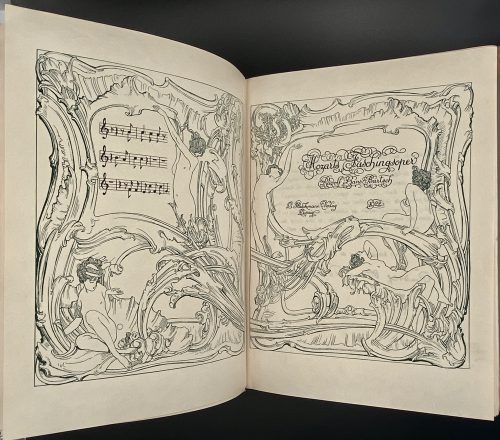 Of the limited edition of 1150 copies, this is №54 (on Japan paper, signed by Bartsch and by von Bayros). Owner's binding imitating quarter-morocco, a red label with gilt lettering to spine (possibly by Ms Hunt, who was an amateur bookbinder). Bookplate on front pastedown: "Ex libris Rachel McMasters Miller Hunt | S. B. Hill Dec 1913 | A.J. Downey Sc." Alfred James Downey (1882-1944). Rachel McMasters Miller Hunt (1882-1963). Sarah B. Hill had done lettering for Ms Hunt. On back pastedown: Stamp "Hunt Libraries CMU" and sticker "Gotham Book Mart | 128 West 45th street | New York". This is from an edition of Carcassonne:
Of the limited edition of 1150 copies, this is №54 (on Japan paper, signed by Bartsch and by von Bayros). Owner's binding imitating quarter-morocco, a red label with gilt lettering to spine (possibly by Ms Hunt, who was an amateur bookbinder). Bookplate on front pastedown: "Ex libris Rachel McMasters Miller Hunt | S. B. Hill Dec 1913 | A.J. Downey Sc." Alfred James Downey (1882-1944). Rachel McMasters Miller Hunt (1882-1963). Sarah B. Hill had done lettering for Ms Hunt. On back pastedown: Stamp "Hunt Libraries CMU" and sticker "Gotham Book Mart | 128 West 45th street | New York". This is from an edition of Carcassonne:
-
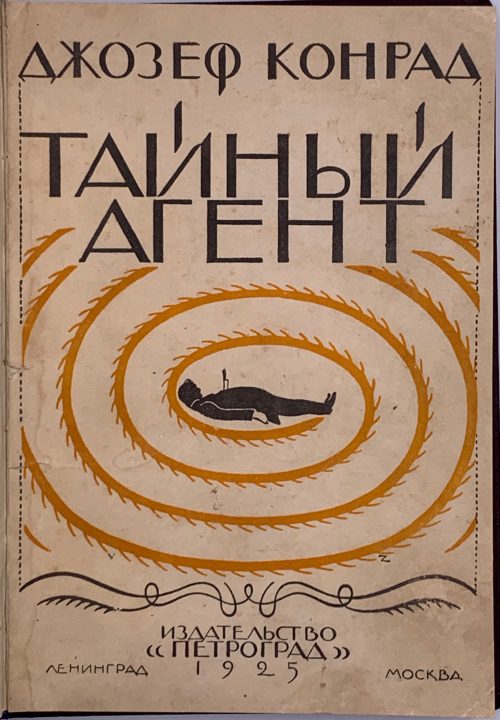 20 x 14.5 cm, owner’s burgundy buckram, upper original pictorial wrapper preserved, in black and yellow. Title: ДЖОЗЕФ КОНРАД | ТАЙНЫЙ АГЕНТ | (The secret agent) | Перевод с английского | М. МАТВЕЕВОЙ | под редакцией | В. А. АЗОВА | {device} | Издательство “ПЕТРОГРАД” | ЛЕНИНГРАД — МОСКВА | 1925. Pagination: ffl, [2] orig. wrapper/blank, [1, 2] t.p./imprint, 3-245 [3 advert.] Collation: 8vo; [1]8 2-158 164. Print run: 5.000 copies. Редактор перевода: В. А. Азов Contributors: Joseph Conrad (Polish-British, 1857 – 1924) – author. Владимир Александрович Ашкинази [Азов] (Russian-French, 1873 – 1941) – translator/editor. Марианна Николаевна Матвеева (Russian, 20th century) – translator. Original title: [LIB-2762.2021] Joseph Conrad. The secret agent: a simple tale. — London: Methuen & Co., [1907]; [LIB-3213.2023] Joseph Conrad. The secret agent: A drama in three acts. — London, T. Werner Laurie., 1923.
20 x 14.5 cm, owner’s burgundy buckram, upper original pictorial wrapper preserved, in black and yellow. Title: ДЖОЗЕФ КОНРАД | ТАЙНЫЙ АГЕНТ | (The secret agent) | Перевод с английского | М. МАТВЕЕВОЙ | под редакцией | В. А. АЗОВА | {device} | Издательство “ПЕТРОГРАД” | ЛЕНИНГРАД — МОСКВА | 1925. Pagination: ffl, [2] orig. wrapper/blank, [1, 2] t.p./imprint, 3-245 [3 advert.] Collation: 8vo; [1]8 2-158 164. Print run: 5.000 copies. Редактор перевода: В. А. Азов Contributors: Joseph Conrad (Polish-British, 1857 – 1924) – author. Владимир Александрович Ашкинази [Азов] (Russian-French, 1873 – 1941) – translator/editor. Марианна Николаевна Матвеева (Russian, 20th century) – translator. Original title: [LIB-2762.2021] Joseph Conrad. The secret agent: a simple tale. — London: Methuen & Co., [1907]; [LIB-3213.2023] Joseph Conrad. The secret agent: A drama in three acts. — London, T. Werner Laurie., 1923. -
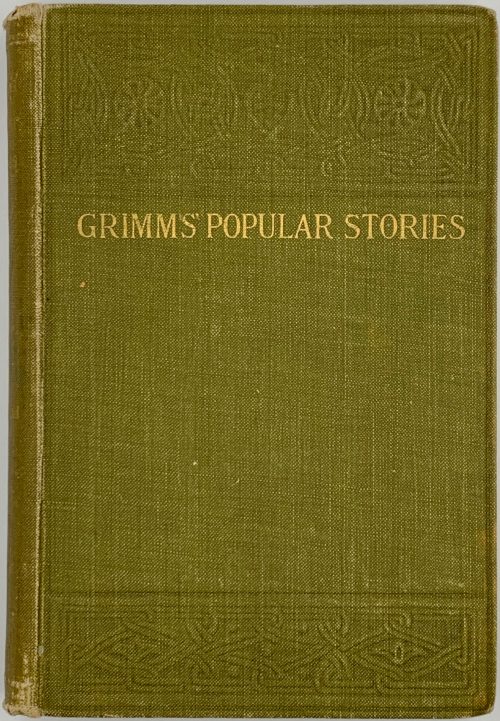 Title: OXFORD EDITION | POPULAR STORIES | COLLECTED BY | THE BROTHERS GRIMM | A REPRINT OF THE FIRST ENGLISH EDITION | WITH TWENTY-TWO ILLUSTRATIONS | BY GEORGE CRUIKSHANK | {publisher’s device} | HENRY FROWDE | LONDON, EDINBURGH, GLASGOW | NEW YORK AND TORONTO | 1905 || Pagination: [i, ii] – frontis., [iii-iv]– t.p. / imprint. [v] – preface, vi-xvii [xviii blank], [2] [1] 2-403 [404], plates included in pagination, pp. 379-403 – notes. Collation: a8 b2 B-Z8 Aa-Cc8 Dd2. Binding:1 9 x 13 cm, olive green cloth blind-stamped in art nouveau style and lettered in gilt to cover and spine: GRIMMS’ POPULAR STORIES. Aubergine pencil inscription to front pastedown: C. Grant Robertson | All Souls | 1905: Provenance: Sir Charles Grant Robertson CVO (British, 1869 – 1948) who was a British academic historian, a Fellow of All Souls College, Oxford, and Vice-chancellor of the University of Birmingham.
Title: OXFORD EDITION | POPULAR STORIES | COLLECTED BY | THE BROTHERS GRIMM | A REPRINT OF THE FIRST ENGLISH EDITION | WITH TWENTY-TWO ILLUSTRATIONS | BY GEORGE CRUIKSHANK | {publisher’s device} | HENRY FROWDE | LONDON, EDINBURGH, GLASGOW | NEW YORK AND TORONTO | 1905 || Pagination: [i, ii] – frontis., [iii-iv]– t.p. / imprint. [v] – preface, vi-xvii [xviii blank], [2] [1] 2-403 [404], plates included in pagination, pp. 379-403 – notes. Collation: a8 b2 B-Z8 Aa-Cc8 Dd2. Binding:1 9 x 13 cm, olive green cloth blind-stamped in art nouveau style and lettered in gilt to cover and spine: GRIMMS’ POPULAR STORIES. Aubergine pencil inscription to front pastedown: C. Grant Robertson | All Souls | 1905: Provenance: Sir Charles Grant Robertson CVO (British, 1869 – 1948) who was a British academic historian, a Fellow of All Souls College, Oxford, and Vice-chancellor of the University of Birmingham. -
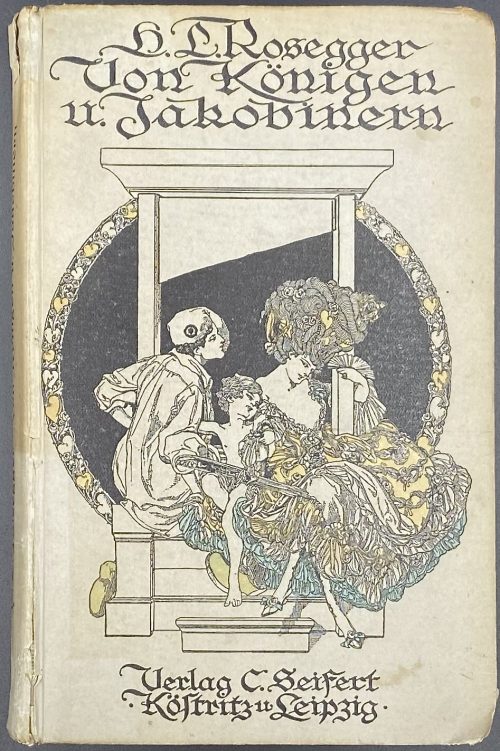 Cover (in blackletter): H. L. Rosegger. | Von Königen u. Jakobinern | {vignette by von Bayros} | Verlag C. Seifert | • Köstritz u Leipzig • || Title (blackletter): Von Königen | und Jakobinern | Von | Hans Ludwig Rosegger | mit vier Vollbildern und Buchschmuck | von Marquis F. von Bayros | {publisher’s device} | 1913 | C. Seifert Verlag, G.m.b.H. | Köstritz und Leipzig || Pagination: [2] – t.p. / blank, [2] – contents / blank, [1-3] 4-263 [264 vignette, colophon], 4 plates extraneous to collation, 2 vignettes. Collation: 8vo; 1-168 174. Binding: Hardcover, pictorial paper boards, lettering to spine, lettering and vignette by von Bayros to cover. Owner's inscription to ffl: "T. Lewe. März, 1919."
Cover (in blackletter): H. L. Rosegger. | Von Königen u. Jakobinern | {vignette by von Bayros} | Verlag C. Seifert | • Köstritz u Leipzig • || Title (blackletter): Von Königen | und Jakobinern | Von | Hans Ludwig Rosegger | mit vier Vollbildern und Buchschmuck | von Marquis F. von Bayros | {publisher’s device} | 1913 | C. Seifert Verlag, G.m.b.H. | Köstritz und Leipzig || Pagination: [2] – t.p. / blank, [2] – contents / blank, [1-3] 4-263 [264 vignette, colophon], 4 plates extraneous to collation, 2 vignettes. Collation: 8vo; 1-168 174. Binding: Hardcover, pictorial paper boards, lettering to spine, lettering and vignette by von Bayros to cover. Owner's inscription to ffl: "T. Lewe. März, 1919." -
![Гроций. О праве войны и мира // Общедоступная философия в изложении Аркадия Пресса. - СПб.: П. П. Сойкин, [1902].](https://varshavskycollection.com/wp-content/uploads/2021/02/LIB-0905.2015-3-500x781.jpeg) Front wrapper, t.p.: Общедоступная философiя | ВЪ ИЗЛОЖЕНИИ | АРКАДIЯ ПРЕССА | — | ГРОЦIЙ. | О ПРАВѢ ВОЙНЫ И МИРА. | Цена 40 коп. | [two medals] С.-Петербург | Изданiе П. П. Сойкина [two medals] | Книжный Складъ / Стремянная, 12 | Книжный Магазинъ / Невский, 96 || Verso to front wrapper: publisher's advert.; verso to back wrapper: publisher's advert.; back wrapper: Series advert. Series: Общедоступная философия в изложении Аркадия Пресса Pagination: [1, 2] – t.p. /censor's approval dated September 30, 1902 г., imprint, [3] 4-50 [2] – publisher's advert. Collation: 8vo; [1]8 2-38 42. Inscriptions: Handwriting to front wrapper "1902"; to title page "1902" and in Russian: "Ензику от Тышки 19/III-26г." Size: 19.5 x 12.3 cm. Binding: original publisher's wrappers, lettering, pp. 35-46 loose. Author: Hugo Grotius [Huig or Hugo de Groot] (Dutch, 1583 – 1645). Originally published by Nicolas Buon in Paris in 1625 in Latin under the title: De iure belli ac pacis (English: On the Law of War and Peace). Compiler/translator: Аркадий Германович Пресс [Аркадиус Пресас or Arkadius Presas] (Russian-Finish, 1870 – 1952).
Front wrapper, t.p.: Общедоступная философiя | ВЪ ИЗЛОЖЕНИИ | АРКАДIЯ ПРЕССА | — | ГРОЦIЙ. | О ПРАВѢ ВОЙНЫ И МИРА. | Цена 40 коп. | [two medals] С.-Петербург | Изданiе П. П. Сойкина [two medals] | Книжный Складъ / Стремянная, 12 | Книжный Магазинъ / Невский, 96 || Verso to front wrapper: publisher's advert.; verso to back wrapper: publisher's advert.; back wrapper: Series advert. Series: Общедоступная философия в изложении Аркадия Пресса Pagination: [1, 2] – t.p. /censor's approval dated September 30, 1902 г., imprint, [3] 4-50 [2] – publisher's advert. Collation: 8vo; [1]8 2-38 42. Inscriptions: Handwriting to front wrapper "1902"; to title page "1902" and in Russian: "Ензику от Тышки 19/III-26г." Size: 19.5 x 12.3 cm. Binding: original publisher's wrappers, lettering, pp. 35-46 loose. Author: Hugo Grotius [Huig or Hugo de Groot] (Dutch, 1583 – 1645). Originally published by Nicolas Buon in Paris in 1625 in Latin under the title: De iure belli ac pacis (English: On the Law of War and Peace). Compiler/translator: Аркадий Германович Пресс [Аркадиус Пресас or Arkadius Presas] (Russian-Finish, 1870 – 1952). -
![[Philip Graves]. The Truth About "The Protocols" : A Literary Forgery / From the Times of August 16, 17, and 18, 1921. — London: [The Times, 1921]. — pp.: [2 title, coloph.] 3-24.](https://varshavskycollection.com/wp-content/uploads/2021/02/LIB-2496.2020-a-500x796.jpeg) A contemporary reprint in publisher's wrappers, 22.8 x 14.4 cm, untrimmed, stapled, with title on the outer cover and similar to t.p.: The Truth About | "The Protocols" | A LITERARY FORGERY | From The Times of | August 16, 17, and 18, 1921 | LONDON: | PRINTING HOUSE SQUARE, E.C.4. | ONE SHILLING NET. || Pagination: [2] – t.p. / colophon, 3-24. Collation: [A]2 B10.
A contemporary reprint in publisher's wrappers, 22.8 x 14.4 cm, untrimmed, stapled, with title on the outer cover and similar to t.p.: The Truth About | "The Protocols" | A LITERARY FORGERY | From The Times of | August 16, 17, and 18, 1921 | LONDON: | PRINTING HOUSE SQUARE, E.C.4. | ONE SHILLING NET. || Pagination: [2] – t.p. / colophon, 3-24. Collation: [A]2 B10. -
![Н. Л. [Бутми де Кацман Георгий Васильевич]. Фран-масонство и государственная измена. Издание В. П. — СПб.: тип. газеты "Россiя", 1906. — 77 стр.](https://varshavskycollection.com/wp-content/uploads/2021/02/LIB-0940.2016-a-500x719.jpeg) Cover and title page: Н. Л. | ФРАН-МАСОНСТВО | И | ГОСУДАРСТВЕННАЯ ИЗМѢНА. | Изданiе В. П. | С.-ПЕТЕРБУРГЪ | Типографиiя газеты «Россiя». Бассейная, 3. | 1906 г. || Pagination: [1-3] 4-77 [3]; collation: [1]8 2-58; 23 x 15.5 cm, in publisher’s lettered wrappers, library and bookstore stamps. A reprint of an article published in № 4 of the magazine "Море и его Жизнь", January 1905. Allegedly a translation and a brief exposition of La franc-maçonnerie et la Révolution française by Maurice Talmeyr [Marie-Justin-Maurice Coste] (French, –
Cover and title page: Н. Л. | ФРАН-МАСОНСТВО | И | ГОСУДАРСТВЕННАЯ ИЗМѢНА. | Изданiе В. П. | С.-ПЕТЕРБУРГЪ | Типографиiя газеты «Россiя». Бассейная, 3. | 1906 г. || Pagination: [1-3] 4-77 [3]; collation: [1]8 2-58; 23 x 15.5 cm, in publisher’s lettered wrappers, library and bookstore stamps. A reprint of an article published in № 4 of the magazine "Море и его Жизнь", January 1905. Allegedly a translation and a brief exposition of La franc-maçonnerie et la Révolution française by Maurice Talmeyr [Marie-Justin-Maurice Coste] (French, – -
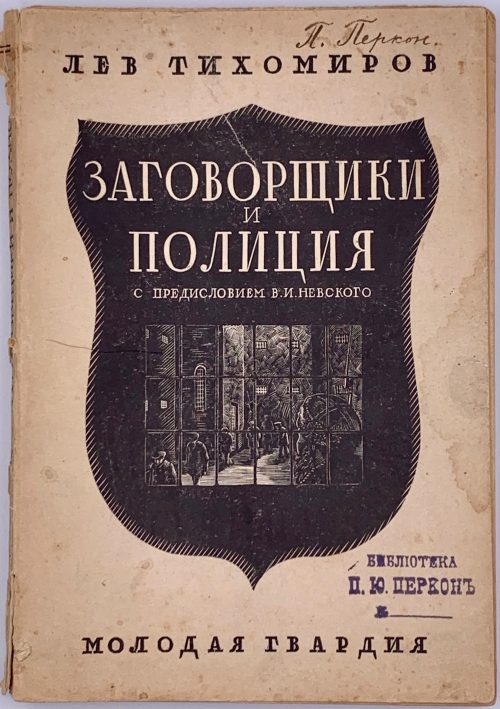 Front pictorial wrapper: ЛЕВ ТИХОМИРОВ | ЗАГОВОРЩИКИ | И | ПОЛИЦИЯ | С ПРЕДИСЛОВИЕМ В. И. НЕВСКОГО | МОЛОДАЯ ГВАРДИЯ || Title page: РЕВОЛЮЦИОННОЕ ДВИЖЕНИЕ В РОССИИ В МЕМУАРАХ | СОВРЕМЕННИКОВ | ПОД РЕДАКЦИЕЙ В. НЕВСКОГО И П. АНАТОЛЬЕВА | ЛЕВ ТИХОМИРОВ | ЗАГОВОРЩИКИ | И | ПОЛИЦИЯ | ПРЕДИСЛОВИЕ В. НЕВСКОГО | МОЛОДАЯ ГВАРДИЯ | МОСКВА – ЛЕНИНГРАД || Title verso: Обложка – гравюра на дереве | работы Н. П. Дмитровского | {printer’s device} | Издат. № 2633 | Ленинградский Областлит № 8371 | Тираж 5.000 экз. | 1928 г. Back wrapper: Заказы направлять: | [….] | {publisher’s device} | 1 р. 25 коп. | Р || Pagination: [1-3] 4-229 [3]; pp. 205-226 – notes, 227-229 – index. Collation: [1]8 2-148 154. Binding: publisher’s pictorial wrappers, lettering to spine and back cover. Print run 5,000 copies. Provenance: П. Ю. Перкон (to front cover nut-ink inscription: «П. Перкон», blue ink stamp to cover and t.p.: «БИБЛИОТЕКА | П. Ю. ПЕРКОНЪ | №» Personae: Перкон, Петр Юрьевич [Густавович] (Latvian, 1885 – 1938) — member of the communist party (Bolsheviks) since 05.1905; arrested: 05.02.1938, shot: 22.04.1938. — Previous owner. Невский, Владимир Иванович [Кривобоков or Кривобок, Феодосий Иванович] (Russian, 1876 – 1937) — arrested: 20.02.1935, shot: 26.05.1937. — Editor of the series and author of the foreword. Анатольев, П. И. [Фаресов, Анатолий Иванович; Faresov, Anatoly (Russian, 1852 – 1928). — Editor of the series. Тихомиров, Лев Александрович (Russian, 1852 – 1923). — Author of the text. Дмитревский [Дмитриевский; Дмитровский], Николай Павлович (Russian, 1890 — 1938) — arrested 15.12.1937 , shot: 02.01.1938. — Artist/engraver of the woodcut on the cover.
Front pictorial wrapper: ЛЕВ ТИХОМИРОВ | ЗАГОВОРЩИКИ | И | ПОЛИЦИЯ | С ПРЕДИСЛОВИЕМ В. И. НЕВСКОГО | МОЛОДАЯ ГВАРДИЯ || Title page: РЕВОЛЮЦИОННОЕ ДВИЖЕНИЕ В РОССИИ В МЕМУАРАХ | СОВРЕМЕННИКОВ | ПОД РЕДАКЦИЕЙ В. НЕВСКОГО И П. АНАТОЛЬЕВА | ЛЕВ ТИХОМИРОВ | ЗАГОВОРЩИКИ | И | ПОЛИЦИЯ | ПРЕДИСЛОВИЕ В. НЕВСКОГО | МОЛОДАЯ ГВАРДИЯ | МОСКВА – ЛЕНИНГРАД || Title verso: Обложка – гравюра на дереве | работы Н. П. Дмитровского | {printer’s device} | Издат. № 2633 | Ленинградский Областлит № 8371 | Тираж 5.000 экз. | 1928 г. Back wrapper: Заказы направлять: | [….] | {publisher’s device} | 1 р. 25 коп. | Р || Pagination: [1-3] 4-229 [3]; pp. 205-226 – notes, 227-229 – index. Collation: [1]8 2-148 154. Binding: publisher’s pictorial wrappers, lettering to spine and back cover. Print run 5,000 copies. Provenance: П. Ю. Перкон (to front cover nut-ink inscription: «П. Перкон», blue ink stamp to cover and t.p.: «БИБЛИОТЕКА | П. Ю. ПЕРКОНЪ | №» Personae: Перкон, Петр Юрьевич [Густавович] (Latvian, 1885 – 1938) — member of the communist party (Bolsheviks) since 05.1905; arrested: 05.02.1938, shot: 22.04.1938. — Previous owner. Невский, Владимир Иванович [Кривобоков or Кривобок, Феодосий Иванович] (Russian, 1876 – 1937) — arrested: 20.02.1935, shot: 26.05.1937. — Editor of the series and author of the foreword. Анатольев, П. И. [Фаресов, Анатолий Иванович; Faresov, Anatoly (Russian, 1852 – 1928). — Editor of the series. Тихомиров, Лев Александрович (Russian, 1852 – 1923). — Author of the text. Дмитревский [Дмитриевский; Дмитровский], Николай Павлович (Russian, 1890 — 1938) — arrested 15.12.1937 , shot: 02.01.1938. — Artist/engraver of the woodcut on the cover. -
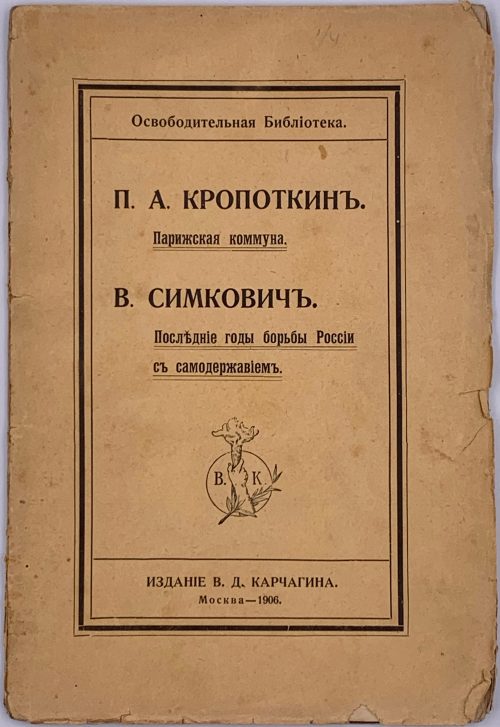 Cover and title page: Освободительная библiотека. | П. А. КРОПОТКИНЪ. | Парижская коммуна | В. СИМКОВИЧЪ | Послѣдние годы борьбы Россiи | съ самодержавiемъ | {publisher’s device} | ИЗДАНIЕ В. Д. КАРЧАГИНА. | Москва—1906. || Publisher’s lettered wrappers, pagination: [1-5] 6-83 [84], collation: 8vo, [1]8 2-58 62; size: 10.5 x 14 cm. Contents: П. А. Кропоткин. Парижская коммуна / Пер. Т. Брона — pp. 3-31; В. Симкович. Последнии годы борьбы России с самодержавием / Пер. Л. П. Данилова — pp. 33- 83. Kropotkin, Pyotr Alexeyevich [Кропоткин, Пётр Алексеевич] (Russian, 1842 – 1921) — author of the text. Simkhovitch, Vladimir Gregorievitch [Симкович, В.] (Russian-American, 1874 – 1959) — author of the text. Кушнерёв, Иван Николаевич (Russian, 1827 – 1896) — printer.
Cover and title page: Освободительная библiотека. | П. А. КРОПОТКИНЪ. | Парижская коммуна | В. СИМКОВИЧЪ | Послѣдние годы борьбы Россiи | съ самодержавiемъ | {publisher’s device} | ИЗДАНIЕ В. Д. КАРЧАГИНА. | Москва—1906. || Publisher’s lettered wrappers, pagination: [1-5] 6-83 [84], collation: 8vo, [1]8 2-58 62; size: 10.5 x 14 cm. Contents: П. А. Кропоткин. Парижская коммуна / Пер. Т. Брона — pp. 3-31; В. Симкович. Последнии годы борьбы России с самодержавием / Пер. Л. П. Данилова — pp. 33- 83. Kropotkin, Pyotr Alexeyevich [Кропоткин, Пётр Алексеевич] (Russian, 1842 – 1921) — author of the text. Simkhovitch, Vladimir Gregorievitch [Симкович, В.] (Russian-American, 1874 – 1959) — author of the text. Кушнерёв, Иван Николаевич (Russian, 1827 – 1896) — printer. -
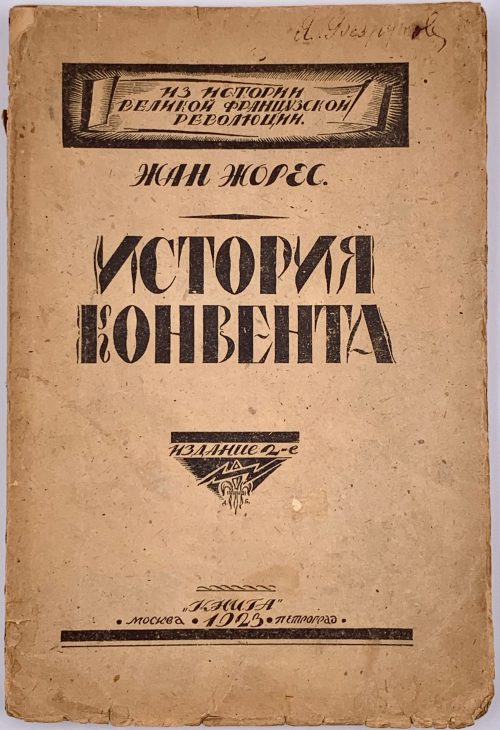 Cover: ИЗ ИСТОРИИ | ВЕЛИКОЙ ФРАНЦУЗСКОЙ | РЕВОЛЮЦИИ | ЖАН ЖОРЕС | ИСТОРИЯ КОНВЕНТА | ИЗДАНИЕ 2-е | “Книга” | • МОСКВА • 1923 • ПЕТРОГРАД • || Title page: Жан Жорес | История Конвента | Сокращенный перевод В. Левицкого | под редакцией Ф. Дана. | Второе издание. | {publisher’s device} | “Книга” | Москва. […] Петроград | Тверская, 38, тел. 2-64-61. […] Невский, 74, тел. 1-34-34. || Print run: 3,000 copies. Printer: 10-я типография МСНХ «Мосполиграф». Original Title: Histoire socialiste : 1789-1900. La convention nationale / par J. Jaurès. — Paris : Jules Rouff et Cie, 1901 Bibliographical description: 23.5 x 16 cm, publisher’s letterpress wrappers, pp. [1-3] 4-191 [192]; collation: 8vo, [1-2]8 3-128; ink inscription to front wrapper: Я. Безруков Jean Jaurès [Жан Жорес] (French, 1859 – 1914) Цедербаум, Владимир Осипович [Левицкий, В.] (Russian-Jewish, 1883 – 1938) Дан [Гурвич], Федор Ильич (Russian-Jewish, 1871-1947)
Cover: ИЗ ИСТОРИИ | ВЕЛИКОЙ ФРАНЦУЗСКОЙ | РЕВОЛЮЦИИ | ЖАН ЖОРЕС | ИСТОРИЯ КОНВЕНТА | ИЗДАНИЕ 2-е | “Книга” | • МОСКВА • 1923 • ПЕТРОГРАД • || Title page: Жан Жорес | История Конвента | Сокращенный перевод В. Левицкого | под редакцией Ф. Дана. | Второе издание. | {publisher’s device} | “Книга” | Москва. […] Петроград | Тверская, 38, тел. 2-64-61. […] Невский, 74, тел. 1-34-34. || Print run: 3,000 copies. Printer: 10-я типография МСНХ «Мосполиграф». Original Title: Histoire socialiste : 1789-1900. La convention nationale / par J. Jaurès. — Paris : Jules Rouff et Cie, 1901 Bibliographical description: 23.5 x 16 cm, publisher’s letterpress wrappers, pp. [1-3] 4-191 [192]; collation: 8vo, [1-2]8 3-128; ink inscription to front wrapper: Я. Безруков Jean Jaurès [Жан Жорес] (French, 1859 – 1914) Цедербаум, Владимир Осипович [Левицкий, В.] (Russian-Jewish, 1883 – 1938) Дан [Гурвич], Федор Ильич (Russian-Jewish, 1871-1947) -
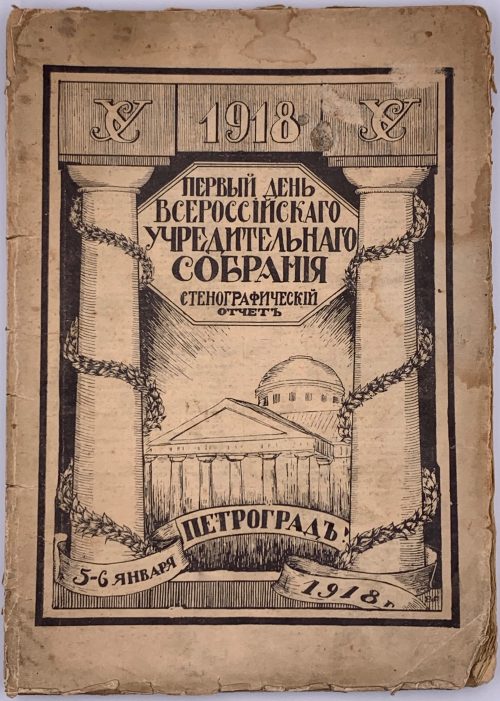 Cover: УС 1918 УС | ПЕРВЫЙ ДЕНЬ | ВСЕРОССIЙСКАГО | УЧРЕДИТЕЛЬНАГО | СОБРАНIЯ | СТЕНОГРАФИЧЕСКIЙ | ОТЧЕТЪ | 5-6 ЯНВАРЯ […] ПЕТРОГРАДЪ […] 1918 г. Title page: УЧРЕДИТЕЛЬНОЕ | СОБРАНIЕ | СТЕНОГРАФИЧЕСКIЙ ОТЧЕТЪ | ПЕЧАТАЕТСЯ ПО РАСПОРЯЖЕНIЮ ПРЕДСѢДАТЕЛЯ | УЧРЕДИТЕЛЬНАГО СОБРАНIЯ. | ПЕТРОГРАДЪ | Пятая Государственная типография, Стремянная, 12. | 1918. || Pencil inscription to t.p.: "Москва 1923 г. С. Варшавский". 23 x 16.5 cm, publisher’s pictorial wrappers, woodcut to front cover, pp.: [1-3] 4-112; collation: [1]8 2-78.
Cover: УС 1918 УС | ПЕРВЫЙ ДЕНЬ | ВСЕРОССIЙСКАГО | УЧРЕДИТЕЛЬНАГО | СОБРАНIЯ | СТЕНОГРАФИЧЕСКIЙ | ОТЧЕТЪ | 5-6 ЯНВАРЯ […] ПЕТРОГРАДЪ […] 1918 г. Title page: УЧРЕДИТЕЛЬНОЕ | СОБРАНIЕ | СТЕНОГРАФИЧЕСКIЙ ОТЧЕТЪ | ПЕЧАТАЕТСЯ ПО РАСПОРЯЖЕНIЮ ПРЕДСѢДАТЕЛЯ | УЧРЕДИТЕЛЬНАГО СОБРАНIЯ. | ПЕТРОГРАДЪ | Пятая Государственная типография, Стремянная, 12. | 1918. || Pencil inscription to t.p.: "Москва 1923 г. С. Варшавский". 23 x 16.5 cm, publisher’s pictorial wrappers, woodcut to front cover, pp.: [1-3] 4-112; collation: [1]8 2-78. -
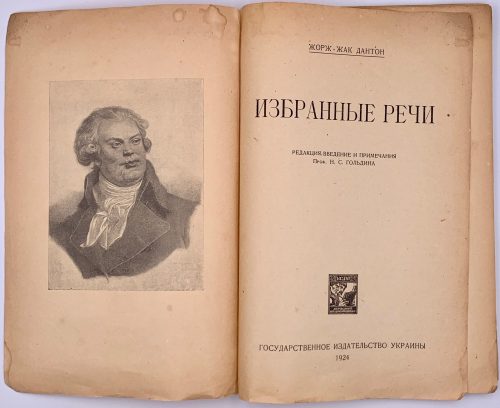 Title page: ЖОРЖ-ЖАК ДАНТОН | ИЗБРАННЫЕ РЕЧИ | РЕДАКЦИЯ, ВВЕДЕНИЕ И ПРИМЕЧАНИЯ | Проф. Н. С. ГОЛЬДИНА | {publisher’s device} | ГОСУДАРСТВЕННОЕ ИЗДАТЕЛЬСТВО УКРАИНЫ | 1924 Lacking wrappers, [2] – blank / frontispiece portrait of Danton, [2] t.p., / imprint, v-xviii, [2] –f.t / blank, 1-111 [112], collation: π2 *8 1-78. Danton, Georges Jacques [Дантон, Жорж Жак] (French, 1759 – 1794). Гольдин, Николай Сергеевич (Ukrainian-Jewish, 1877 – after 1924). Translator unknown.
Title page: ЖОРЖ-ЖАК ДАНТОН | ИЗБРАННЫЕ РЕЧИ | РЕДАКЦИЯ, ВВЕДЕНИЕ И ПРИМЕЧАНИЯ | Проф. Н. С. ГОЛЬДИНА | {publisher’s device} | ГОСУДАРСТВЕННОЕ ИЗДАТЕЛЬСТВО УКРАИНЫ | 1924 Lacking wrappers, [2] – blank / frontispiece portrait of Danton, [2] t.p., / imprint, v-xviii, [2] –f.t / blank, 1-111 [112], collation: π2 *8 1-78. Danton, Georges Jacques [Дантон, Жорж Жак] (French, 1759 – 1794). Гольдин, Николай Сергеевич (Ukrainian-Jewish, 1877 – after 1924). Translator unknown. -
 Pictorial title by von Bayros: Die | Bohème. | Scenen aus dem Pariser | Künstlerleben | von | Henri Murger | Leipzig im | InselVerlag | 1906. | F. Bayros || Pagination: [2] – pictorial frontispiece, [2] – pictorial t.p., 1-280 [2] – inhalt, [2] – colophon, [2] – blank, + 4 plates drawn by Franz von Bayros and reproduced as photogravure, with guards. Binding: 23.5 x 15.5 cm, cream parchment, raised bands, gilt-lettered orange morocco label to spine; text printed on laid paper (Linden Paper watermark), untrimmed, illustrations on wove paper as photogravure. Bookplate: “Ex libris Walter Schniewind” engraved by C. L. Becker. Original title: Henry Murger. Scenes De La Vie De Boheme. — Paris: Michel Lévy frères, 1851. Tirage: 50 copies on laid paper, of which this is № 14 (per Sarkowski: 50 numerierte Ex. auf Bütten. Pergament mit Goldschnitt). Author: Murger, Henri [Murger, Louis-Henri, Henry] (French, 1822 – 1861). Translator: Grove, Frederick Philip [Greve, Felix Paul] (German-Canadian, 1879 – 1948). Illustrator: Bayros, Franz von (Austrian, 1866 – 1924). Printer: Drugulin, Wilhelm Eduard (German, 1822 – 1879); Offizin W. Drugulin (Leipzig). Provenance: Schniewind, Walter (German, 1870 – 1927). Catalogue raisonné: Heinz Sarkowski (1999): № 1175 VA, p. 195; Bayros Zeichnungen, pp. 43-46.
Pictorial title by von Bayros: Die | Bohème. | Scenen aus dem Pariser | Künstlerleben | von | Henri Murger | Leipzig im | InselVerlag | 1906. | F. Bayros || Pagination: [2] – pictorial frontispiece, [2] – pictorial t.p., 1-280 [2] – inhalt, [2] – colophon, [2] – blank, + 4 plates drawn by Franz von Bayros and reproduced as photogravure, with guards. Binding: 23.5 x 15.5 cm, cream parchment, raised bands, gilt-lettered orange morocco label to spine; text printed on laid paper (Linden Paper watermark), untrimmed, illustrations on wove paper as photogravure. Bookplate: “Ex libris Walter Schniewind” engraved by C. L. Becker. Original title: Henry Murger. Scenes De La Vie De Boheme. — Paris: Michel Lévy frères, 1851. Tirage: 50 copies on laid paper, of which this is № 14 (per Sarkowski: 50 numerierte Ex. auf Bütten. Pergament mit Goldschnitt). Author: Murger, Henri [Murger, Louis-Henri, Henry] (French, 1822 – 1861). Translator: Grove, Frederick Philip [Greve, Felix Paul] (German-Canadian, 1879 – 1948). Illustrator: Bayros, Franz von (Austrian, 1866 – 1924). Printer: Drugulin, Wilhelm Eduard (German, 1822 – 1879); Offizin W. Drugulin (Leipzig). Provenance: Schniewind, Walter (German, 1870 – 1927). Catalogue raisonné: Heinz Sarkowski (1999): № 1175 VA, p. 195; Bayros Zeichnungen, pp. 43-46. -
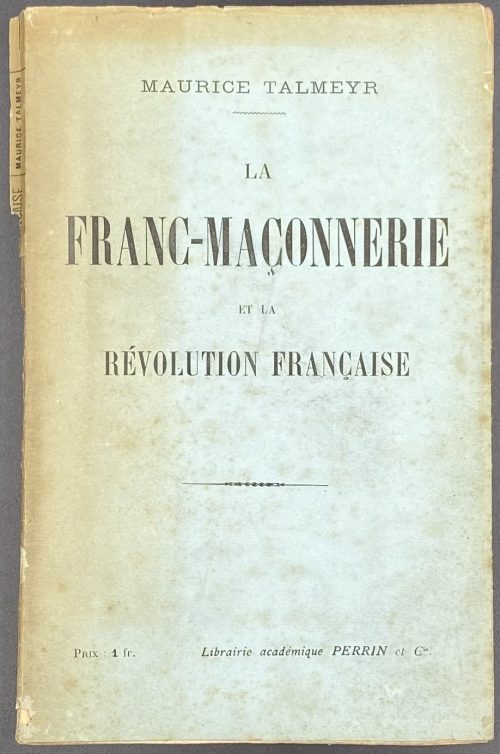 Cover: MAURICE TALMEYR | LA | FRANC-MAÇONNERIE | ET LA | RÉVOLUTION FRANÇAISE | — | Prix : 1 fr. […] Librairie académique PERRIN et Cie. Title page: MAURICE TALMEYR | LA | FRANC-MAÇONNERIE | ET LA | RÉVOLUTION FRANÇAISE | — | PARIS | LIBRAIRIE ACADÉMIQUE DIDIER | PERRIN ET Cie, LIBRAIRES–ÉDITEURS | 35, QUAI DES GRANDS-AUGUSTINS, 35 | 1904 | Tous droits réservés || Autograph: Inscription to h.t. to Charles Foley from the author. Bibiographical description: Blue lettered publisher’s wrappers, 19 x 12 cm, pagination: [8] [1] 2-94 [2], collation: 8vo, π4 1-68. The Russian translation Н. Л. Фран-масонство и государственная измена. — СПб.: Издание В. П., 1906 is here: LIB-0940.2016. Contributors: Maurice Talmeyr [Marie-Justin-Maurice Coste] (French, 1850 – 1931) Pierre-Paul Didier (French, 1800 – 1865) Émile Perrin (French, 1828 – 1884)
Cover: MAURICE TALMEYR | LA | FRANC-MAÇONNERIE | ET LA | RÉVOLUTION FRANÇAISE | — | Prix : 1 fr. […] Librairie académique PERRIN et Cie. Title page: MAURICE TALMEYR | LA | FRANC-MAÇONNERIE | ET LA | RÉVOLUTION FRANÇAISE | — | PARIS | LIBRAIRIE ACADÉMIQUE DIDIER | PERRIN ET Cie, LIBRAIRES–ÉDITEURS | 35, QUAI DES GRANDS-AUGUSTINS, 35 | 1904 | Tous droits réservés || Autograph: Inscription to h.t. to Charles Foley from the author. Bibiographical description: Blue lettered publisher’s wrappers, 19 x 12 cm, pagination: [8] [1] 2-94 [2], collation: 8vo, π4 1-68. The Russian translation Н. Л. Фран-масонство и государственная измена. — СПб.: Издание В. П., 1906 is here: LIB-0940.2016. Contributors: Maurice Talmeyr [Marie-Justin-Maurice Coste] (French, 1850 – 1931) Pierre-Paul Didier (French, 1800 – 1865) Émile Perrin (French, 1828 – 1884) -
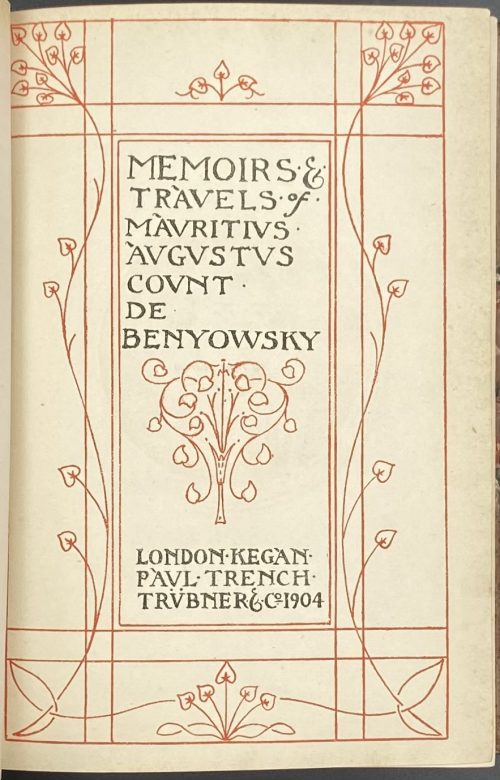 Title: MEMOIRS AND TRAVELS | OF | MAURITIUS AUGUSTUS COUNT DE | BENYOWSKY | MAGNATE OF THE KINGDOMS OF HUNGARY AND POLAND, ONE OF | THE CHIEFS OF THE CONFEDERATION OF POLAND | ETC., ETC. | Consisting of his Military Operations in Poland, his Exile into Kamchatka, | his Escape and Voyage from that Peninsula through the Northern | Pacific Ocean, touching at Japan and Formosa, to Canton | in China, with an Account of the French Settle- | ment he was appointed to form upon the | Island of Madagascar | WITH AN INTRODUCTION, NOTES AND BIBLIOGRAPHY | BY | CAPTAIN S. PASFIELD OLIVER || Half-title (ornamental, in black and red): MEMOIRS & | TRAVELS of | MAURITIUS | AUGUSTUS | COUNT | DE | BENYOWSKY | LONDON•KEGAN• | PAUL•TRENCH• | TRÜBNER•&•Co 1904 || Pagination: [i, ii] – owner pasted wood engraving “A woman of Kamchatka” / Dryden House advert., [iii, iv] – serial title / MAB (years), frontis. Portrait of MAB by Walter L. Colls w/guard, [v, vi] – ornamental h.t / copyright, [vii, viii] – t.p. / list of ill., ix-xxxvi, 1-635 [636]. Collation: 2 blank leaves (binding), [a]-b8 c2 1-398 406, 2 plates, 2 blank leaves (binding). Binding: Modern ¾ morocco over marbled boards, raised bands, gilt fleur-de-lis-cross in compartments, burgundy label with gilt lettering, by Atkinson Book Binders, Salisbury (sticker to back pastedown). Contributors: Printed by Neill and Co., Edinburgh. Published by Kegan Paul, Trench, Trübner & Co.; Kegan Paul, Charles (British, 1828 – 1902). Author: Maurice Auguste comte de Benyowsky [Мориц Август Бенёвский] (Polish-Slovak-Hungarian, 1746 –1786). Editor: Samuel Pasfield Oliver (British, 1838 – 1907). Translator: William Nicholson (British, 1753 – 1815). Originally published in 1790, in London (I have not seen it anywhere) and in Dublin by P. Wogan [etc.], and in 1791 in French, in Paris by Buisson.
Title: MEMOIRS AND TRAVELS | OF | MAURITIUS AUGUSTUS COUNT DE | BENYOWSKY | MAGNATE OF THE KINGDOMS OF HUNGARY AND POLAND, ONE OF | THE CHIEFS OF THE CONFEDERATION OF POLAND | ETC., ETC. | Consisting of his Military Operations in Poland, his Exile into Kamchatka, | his Escape and Voyage from that Peninsula through the Northern | Pacific Ocean, touching at Japan and Formosa, to Canton | in China, with an Account of the French Settle- | ment he was appointed to form upon the | Island of Madagascar | WITH AN INTRODUCTION, NOTES AND BIBLIOGRAPHY | BY | CAPTAIN S. PASFIELD OLIVER || Half-title (ornamental, in black and red): MEMOIRS & | TRAVELS of | MAURITIUS | AUGUSTUS | COUNT | DE | BENYOWSKY | LONDON•KEGAN• | PAUL•TRENCH• | TRÜBNER•&•Co 1904 || Pagination: [i, ii] – owner pasted wood engraving “A woman of Kamchatka” / Dryden House advert., [iii, iv] – serial title / MAB (years), frontis. Portrait of MAB by Walter L. Colls w/guard, [v, vi] – ornamental h.t / copyright, [vii, viii] – t.p. / list of ill., ix-xxxvi, 1-635 [636]. Collation: 2 blank leaves (binding), [a]-b8 c2 1-398 406, 2 plates, 2 blank leaves (binding). Binding: Modern ¾ morocco over marbled boards, raised bands, gilt fleur-de-lis-cross in compartments, burgundy label with gilt lettering, by Atkinson Book Binders, Salisbury (sticker to back pastedown). Contributors: Printed by Neill and Co., Edinburgh. Published by Kegan Paul, Trench, Trübner & Co.; Kegan Paul, Charles (British, 1828 – 1902). Author: Maurice Auguste comte de Benyowsky [Мориц Август Бенёвский] (Polish-Slovak-Hungarian, 1746 –1786). Editor: Samuel Pasfield Oliver (British, 1838 – 1907). Translator: William Nicholson (British, 1753 – 1815). Originally published in 1790, in London (I have not seen it anywhere) and in Dublin by P. Wogan [etc.], and in 1791 in French, in Paris by Buisson. -
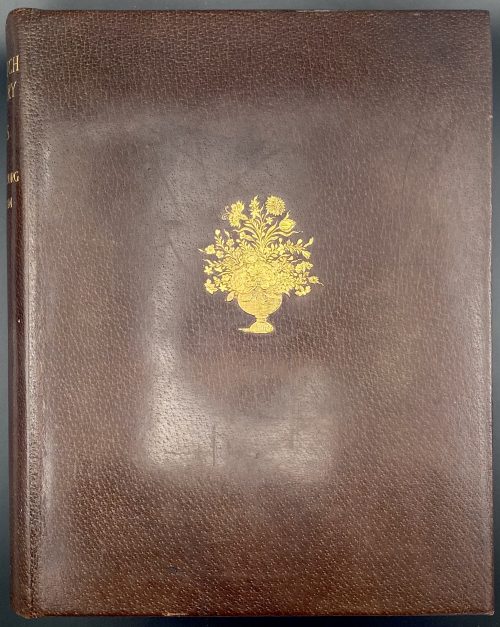 Title: OLD DUTCH | POTTERY AND TILES | BY ELISABETH | NEURDENBURG | LITT. D., READER IN THE HISTORY OF ART AT | THE UNIVERSITY OF GRONINGEN. TRANSLATED | WITH ANNOTATIONS BY | Bernard Rackham | DEPUTY KEEPER, DEPARTMENT | OF CERAMICS, VICTORIA AND | ALBERT MUSEUM | […] | WITH ONE HUNDRED AND TWELVE | ILLUSTRATIONS OF WHICH NINE | ARE IN COLOUR | LONDON: BENN BROTHERS, LIMITED | 8 BOUVERIE STREET, E.C. 4 | 1923 || Verso to half-title: Of this book 100 copies only for sale have been printed on English | hand-made paper, bound in pigskin and signed by the Authoress | and Translator. These copies also contain an extra colour plate. | This in Number “7” (in manuscript) | Two signatures (ink, manuscript) || Pagination: [i, ii] – h.t. / tirage, [iii, iv] – t.p. / imprint, [v, vi] – dedication to Dr. A. Pit / blank, vii-xv [xvi blank] [1, 2] 3-155 [156 blank], frontispiece (colour) and 59 leaves of plates (9 colour) with 112 figures, with lettered protective sheets. Collation: 4to in 8th; [A]8 [B]8 C-K8 L6; frontis., +59 leaves of plates. Binding: 30 x 24 cm, Full dark brown pigskin with gilt ornament to front board and gilt lettering to spine; printed on thick wove paper, top edge gilt, others untrimmed. Contributors: Neurdenburg, Elisabeth (Dutch, 1882 – 1957) – author [autograph]. Rackham, Bernard (British, 1876 – 1964) – translator [autograph]. Brendon, William (British, 1845 – 1928) – printer. Mayflower Press (Plymouth), William Brendon & Son, Ltd. – printer Benn Brothers Ltd. (British company, 1880 – 1987) Benn, Sir John, 1st Baronet (British, 1850 – 1922)
Title: OLD DUTCH | POTTERY AND TILES | BY ELISABETH | NEURDENBURG | LITT. D., READER IN THE HISTORY OF ART AT | THE UNIVERSITY OF GRONINGEN. TRANSLATED | WITH ANNOTATIONS BY | Bernard Rackham | DEPUTY KEEPER, DEPARTMENT | OF CERAMICS, VICTORIA AND | ALBERT MUSEUM | […] | WITH ONE HUNDRED AND TWELVE | ILLUSTRATIONS OF WHICH NINE | ARE IN COLOUR | LONDON: BENN BROTHERS, LIMITED | 8 BOUVERIE STREET, E.C. 4 | 1923 || Verso to half-title: Of this book 100 copies only for sale have been printed on English | hand-made paper, bound in pigskin and signed by the Authoress | and Translator. These copies also contain an extra colour plate. | This in Number “7” (in manuscript) | Two signatures (ink, manuscript) || Pagination: [i, ii] – h.t. / tirage, [iii, iv] – t.p. / imprint, [v, vi] – dedication to Dr. A. Pit / blank, vii-xv [xvi blank] [1, 2] 3-155 [156 blank], frontispiece (colour) and 59 leaves of plates (9 colour) with 112 figures, with lettered protective sheets. Collation: 4to in 8th; [A]8 [B]8 C-K8 L6; frontis., +59 leaves of plates. Binding: 30 x 24 cm, Full dark brown pigskin with gilt ornament to front board and gilt lettering to spine; printed on thick wove paper, top edge gilt, others untrimmed. Contributors: Neurdenburg, Elisabeth (Dutch, 1882 – 1957) – author [autograph]. Rackham, Bernard (British, 1876 – 1964) – translator [autograph]. Brendon, William (British, 1845 – 1928) – printer. Mayflower Press (Plymouth), William Brendon & Son, Ltd. – printer Benn Brothers Ltd. (British company, 1880 – 1987) Benn, Sir John, 1st Baronet (British, 1850 – 1922) -
![Insel-Almanach auf das Jahr 1907. Kalender für 1907. (with illustration by Franz von Bayros on p. 50). — 150 + [2] pp.](https://varshavskycollection.com/wp-content/uploads/2021/02/LIB-2250.2019-a-500x858.jpeg) Half-title: ÜBERREICHT VON | GILHOFER UND RANSCHBURG | SORTIMENT–, BÜCHER– UND KUNST– | ANTIQUARIAT | WIEN 1, BOGNERGASSE 2 || Title: Red letterpress lettering in black ornamental frame: Insel- | Almanach | auf das Jahr | 1907 || Pagination: [6] – h.t., frontis., title; [1-16] 17-150 [2], + 2 folding plates (op. p. 30 and 32), and 2 plates op. p. 50 (Franz von Bayros "Francine" for Die Bohème by Henri Murger) and 112 (colour). Binding: 17.3 x 9.9 cm; original olive paper wrappers with gilt lettering and elements to cover, lettering to spine. Catalogue raisonné: Heinz Sarkowski (1999): № 1986, pp. 329-30, with contents. Contributors: Gilhofer und Ranschburg – antiquarian bookstore in Vienna. Schröder, Rudolf Alexander (German, 1878 – 1962) – title and cover. Wieynk, Heinrich (German, 1874 – 1931) – typeset. Kippenberg, Anton Hermann Friedrich (German, 1874 – 1950) – editor. Brandstetter, Oscar (German, 1844 – ?) – printer.
Half-title: ÜBERREICHT VON | GILHOFER UND RANSCHBURG | SORTIMENT–, BÜCHER– UND KUNST– | ANTIQUARIAT | WIEN 1, BOGNERGASSE 2 || Title: Red letterpress lettering in black ornamental frame: Insel- | Almanach | auf das Jahr | 1907 || Pagination: [6] – h.t., frontis., title; [1-16] 17-150 [2], + 2 folding plates (op. p. 30 and 32), and 2 plates op. p. 50 (Franz von Bayros "Francine" for Die Bohème by Henri Murger) and 112 (colour). Binding: 17.3 x 9.9 cm; original olive paper wrappers with gilt lettering and elements to cover, lettering to spine. Catalogue raisonné: Heinz Sarkowski (1999): № 1986, pp. 329-30, with contents. Contributors: Gilhofer und Ranschburg – antiquarian bookstore in Vienna. Schröder, Rudolf Alexander (German, 1878 – 1962) – title and cover. Wieynk, Heinrich (German, 1874 – 1931) – typeset. Kippenberg, Anton Hermann Friedrich (German, 1874 – 1950) – editor. Brandstetter, Oscar (German, 1844 – ?) – printer. -
![Adelbert von Chamisso. Peter Schlemihls wundersame Geschichte. – Leipzig: Im Insel-Verlag, [1916 or 1923 or 1940] (Series: Insel-Bücherei, Nr. 194). – pp.: ff [1 t.p., 2 blank] 3-79 [80] bf., with 4 etchings [instead of woodcuts] by Adolf Schrödter [1838].](https://varshavskycollection.com/wp-content/uploads/2021/02/LIB-2497.2020-a-500x740.jpeg) Title (Gothic typeset): Peter Schlemihls | wundersame Geschichte | Mitgeteilt | von | Adelbert von Chamisso | {publisher’s device} | — | Im Insel-Verlag zu Leipzig || Series: Insel-Bücherei, Nr. 194. Pagination: 8vo; [1, 2] 3-79 [80]; 4 photomechanical reproductions of woodcuts by Adolf Schrödter [1838] within collation. Binding: 18.5 x 12.5 cm, hardcover, original patterned paper over cardboard, title label in yellow and black pasted to cover, label to spine. According to Herbert Kästner Die Insel-Bücherei: Bibliographie, 1912 - 1999: 4 illustrations by Adolf Schrödter, produced for 1838 edition as wood engravings here reproduced by photogravure. There were four print runs of this edition: 1916: 1.-10. Tsd; 1923: 35. Tsd; 1940: 55. Tsd. There is currently no way to tell which one is this. Contributors: Chamisso, Adelbert von (German, 1781–1838) – author. Schrödter, Adolf (German, 1805 – 1875) – artist.
Title (Gothic typeset): Peter Schlemihls | wundersame Geschichte | Mitgeteilt | von | Adelbert von Chamisso | {publisher’s device} | — | Im Insel-Verlag zu Leipzig || Series: Insel-Bücherei, Nr. 194. Pagination: 8vo; [1, 2] 3-79 [80]; 4 photomechanical reproductions of woodcuts by Adolf Schrödter [1838] within collation. Binding: 18.5 x 12.5 cm, hardcover, original patterned paper over cardboard, title label in yellow and black pasted to cover, label to spine. According to Herbert Kästner Die Insel-Bücherei: Bibliographie, 1912 - 1999: 4 illustrations by Adolf Schrödter, produced for 1838 edition as wood engravings here reproduced by photogravure. There were four print runs of this edition: 1916: 1.-10. Tsd; 1923: 35. Tsd; 1940: 55. Tsd. There is currently no way to tell which one is this. Contributors: Chamisso, Adelbert von (German, 1781–1838) – author. Schrödter, Adolf (German, 1805 – 1875) – artist. -
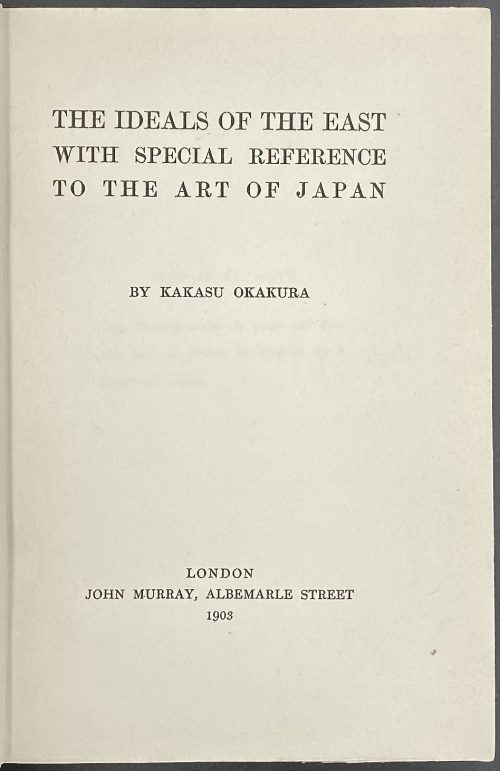 Title: THE IDEALS OF THE EAST | WITH SPECIAL REFERENCE | TO THE ART OF JAPAN | BY KAKASU OKAKURA | LONDON | JOHN MURRAY, ALBEMARLE STREET | 1903 || Collation: 8vo; ffl, [2] (t.p., prep. note) [a]4 b4, A-P8 Q4. Pagination: ffl, [I, ii] – h.t. / blank, [iii, iv] – t.p. / blank, [v, vi] – preparatory note / blank, vii-xxii, [1] 2-244, [1] 2-4 (Works for art lovers). Binding: Burgundy cloth, red flowers and lettering to cover, gilt lettering to spine. Size: 19.5 x 13 cm Contributors: Author: Okakura Kakuzō [岡倉 覚三] (1863 – 1913). Publisher: Murray, Sir John IV (1851–1928); John Murray (publishing house). Printer: Ballantyne, Hanson & Co., Edinburgh, London.
Title: THE IDEALS OF THE EAST | WITH SPECIAL REFERENCE | TO THE ART OF JAPAN | BY KAKASU OKAKURA | LONDON | JOHN MURRAY, ALBEMARLE STREET | 1903 || Collation: 8vo; ffl, [2] (t.p., prep. note) [a]4 b4, A-P8 Q4. Pagination: ffl, [I, ii] – h.t. / blank, [iii, iv] – t.p. / blank, [v, vi] – preparatory note / blank, vii-xxii, [1] 2-244, [1] 2-4 (Works for art lovers). Binding: Burgundy cloth, red flowers and lettering to cover, gilt lettering to spine. Size: 19.5 x 13 cm Contributors: Author: Okakura Kakuzō [岡倉 覚三] (1863 – 1913). Publisher: Murray, Sir John IV (1851–1928); John Murray (publishing house). Printer: Ballantyne, Hanson & Co., Edinburgh, London. -
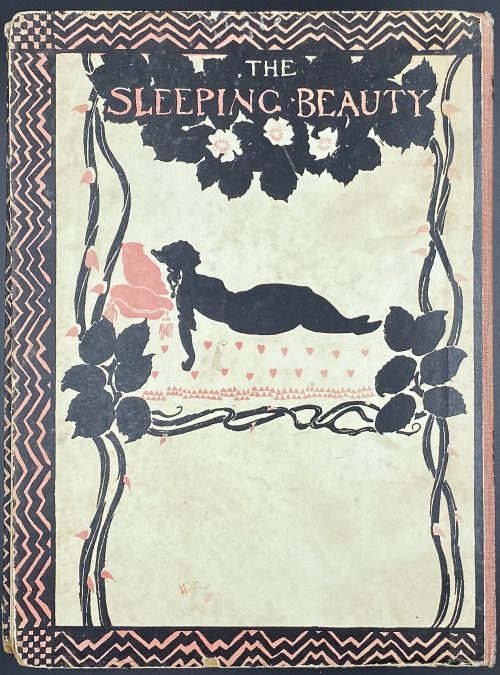 Title: THE SLEEPING | BEAUTY | TOLD BY C S EVANS | AND ILLUSTRATED BY | ARTHUR RACKHAM | LONDON WILLIAM HEINEMANN | PHILADELPHIA J B LIPPINCOTT Co || T.p. verso: LONDON WILLIAM HEINEMANN, 1920. Pagination: [1, 2] – h.t. / advert., [3, 4] – “WH” publisher’s device / frontis., [5, 6] – pictorial t.p. / publisher, year, [7, 8] – silhouette girls / Briar rose w/pasted offset ill., [9] 10-110 [2] – imprint / blank]. Collation: 8vo; B-G8, 3 double-leaf 3-colour woodcut illustrations extraneous to collation, in-text woodcuts. Illustrations: 25 full-page silhouettes, comprising 9 in colour (frontispiece and 4 double plates)--and 16 in black (including 4 double illustrations); one mounted coloured plate; silhouette head- and tailpieces and other silhouettes throughout the text, in black. Binding: Quarter cloth with black lettering, pictorial boards, pictorial endpapers. Size: 26 x 19.5. 1st edition. Inscription to h.t.: "To Dear Julia, Xmas 1947."
Title: THE SLEEPING | BEAUTY | TOLD BY C S EVANS | AND ILLUSTRATED BY | ARTHUR RACKHAM | LONDON WILLIAM HEINEMANN | PHILADELPHIA J B LIPPINCOTT Co || T.p. verso: LONDON WILLIAM HEINEMANN, 1920. Pagination: [1, 2] – h.t. / advert., [3, 4] – “WH” publisher’s device / frontis., [5, 6] – pictorial t.p. / publisher, year, [7, 8] – silhouette girls / Briar rose w/pasted offset ill., [9] 10-110 [2] – imprint / blank]. Collation: 8vo; B-G8, 3 double-leaf 3-colour woodcut illustrations extraneous to collation, in-text woodcuts. Illustrations: 25 full-page silhouettes, comprising 9 in colour (frontispiece and 4 double plates)--and 16 in black (including 4 double illustrations); one mounted coloured plate; silhouette head- and tailpieces and other silhouettes throughout the text, in black. Binding: Quarter cloth with black lettering, pictorial boards, pictorial endpapers. Size: 26 x 19.5. 1st edition. Inscription to h.t.: "To Dear Julia, Xmas 1947." -
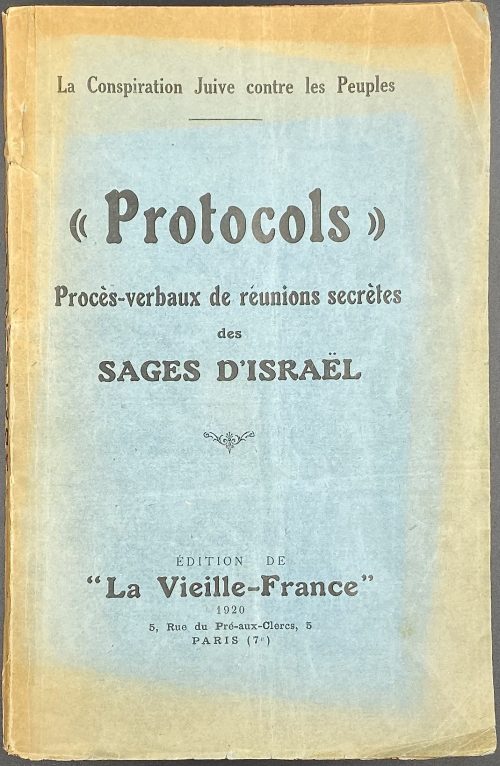 Cover: La Conspiration Juive contre les Peuples | « Protocols » | Procès-verbaux de réunions secrètes | des | SAGES D'ISRAËL | ÉDITION DE | “La Vieille-France” | 1920 | 5Rue du Pré-aux-Clercs, 5 | PARIS (7e) || Title: « Protocols » | Procès-verbaux de réunions secrètes | des | SAGES D'ISRAËL | ÉDITION DE | “La Vieille-France” | 1920 | 5Rue du Pré-aux-Clercs, 5 | PARIS (7e) || Pagination: [1, 2] – t.p. / blank, 3-141 [142 blank] [2] – table / blank. Pp.: 1-11 – Introduction; 13-82 – Protocols; 97-141 – Le Bolchevisme, c’est les Juifs. Collation : 8vo; [1]8 2-98. Binding: Publisher’s blue black-lettered wrappers, lettered spine. Printer: Imprimerie Chantenay (Paris). The French translation of "Протоколы синоских мудрецов" written in Russian by Сергей Нилус (Sergei Nilus, 1862 – 1929) was published in “La Vieille-France” by Urbain Gohier (1862 – 1951). Inside front wrapper: "Brave French! Please note that the format of this book allows you to hide it in your pockets. Your Jewish masters strictly forbid you to read it. Its existence is hidden in every possible way by the Jewish-controlled press. But fear not! While carefully hiding it, read carefully about what your Jewish masters forbid the newspapers to tell you. And you will understand – who and how will take your homeland away from you."
Cover: La Conspiration Juive contre les Peuples | « Protocols » | Procès-verbaux de réunions secrètes | des | SAGES D'ISRAËL | ÉDITION DE | “La Vieille-France” | 1920 | 5Rue du Pré-aux-Clercs, 5 | PARIS (7e) || Title: « Protocols » | Procès-verbaux de réunions secrètes | des | SAGES D'ISRAËL | ÉDITION DE | “La Vieille-France” | 1920 | 5Rue du Pré-aux-Clercs, 5 | PARIS (7e) || Pagination: [1, 2] – t.p. / blank, 3-141 [142 blank] [2] – table / blank. Pp.: 1-11 – Introduction; 13-82 – Protocols; 97-141 – Le Bolchevisme, c’est les Juifs. Collation : 8vo; [1]8 2-98. Binding: Publisher’s blue black-lettered wrappers, lettered spine. Printer: Imprimerie Chantenay (Paris). The French translation of "Протоколы синоских мудрецов" written in Russian by Сергей Нилус (Sergei Nilus, 1862 – 1929) was published in “La Vieille-France” by Urbain Gohier (1862 – 1951). Inside front wrapper: "Brave French! Please note that the format of this book allows you to hide it in your pockets. Your Jewish masters strictly forbid you to read it. Its existence is hidden in every possible way by the Jewish-controlled press. But fear not! While carefully hiding it, read carefully about what your Jewish masters forbid the newspapers to tell you. And you will understand – who and how will take your homeland away from you."


